
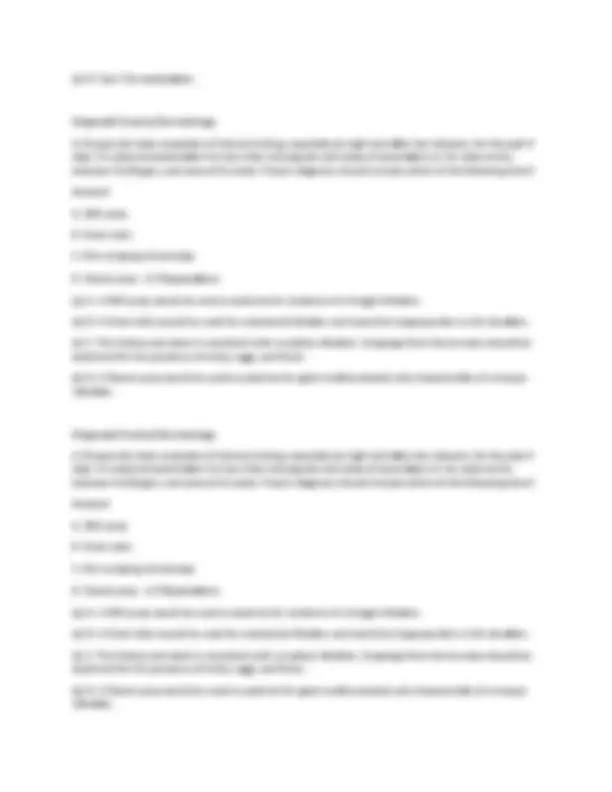
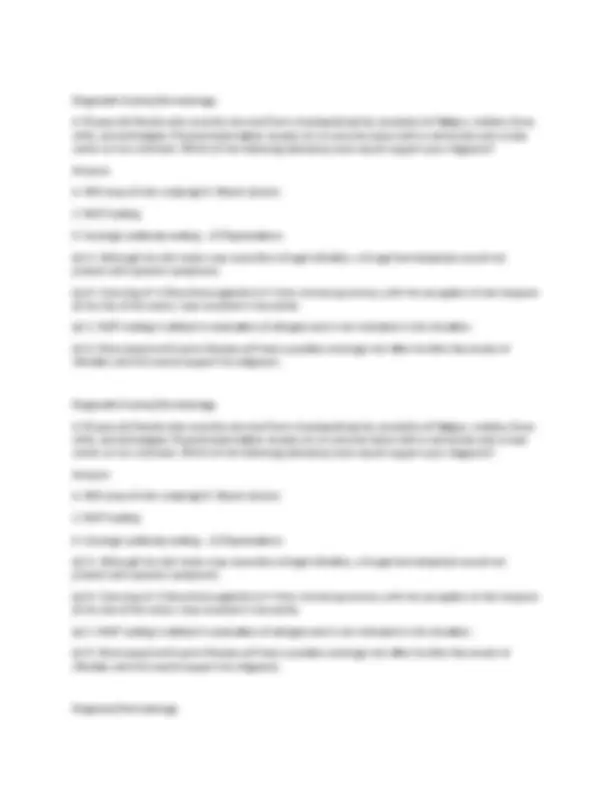
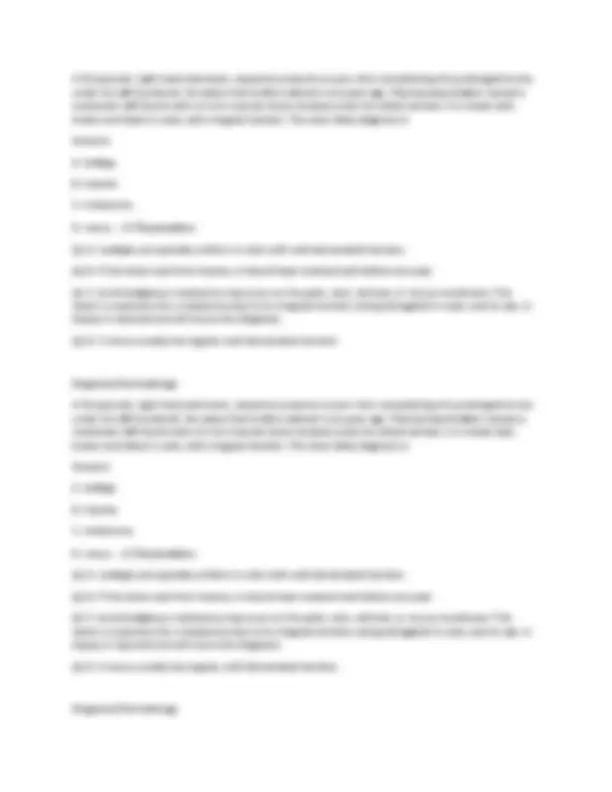
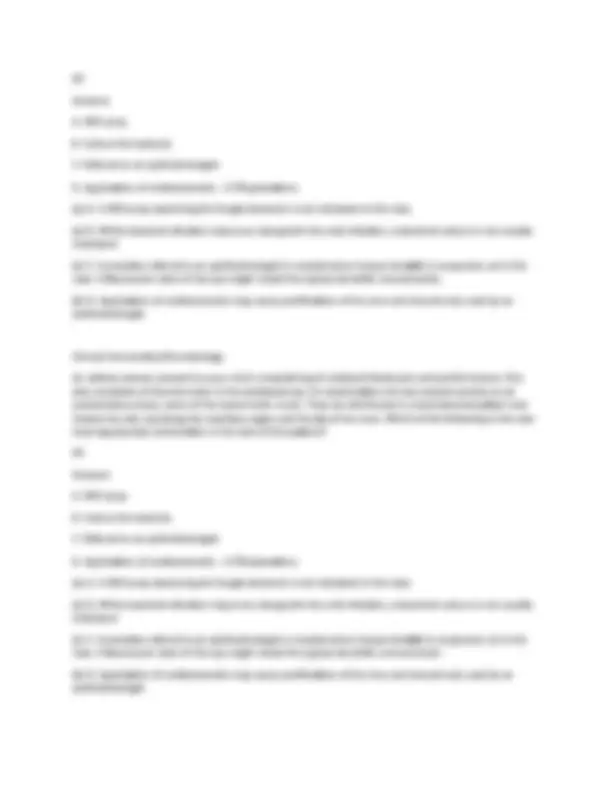
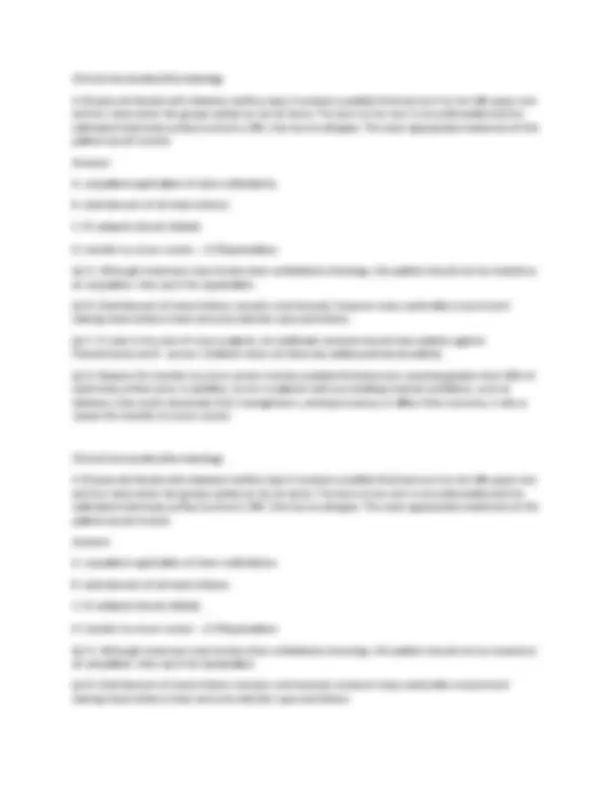

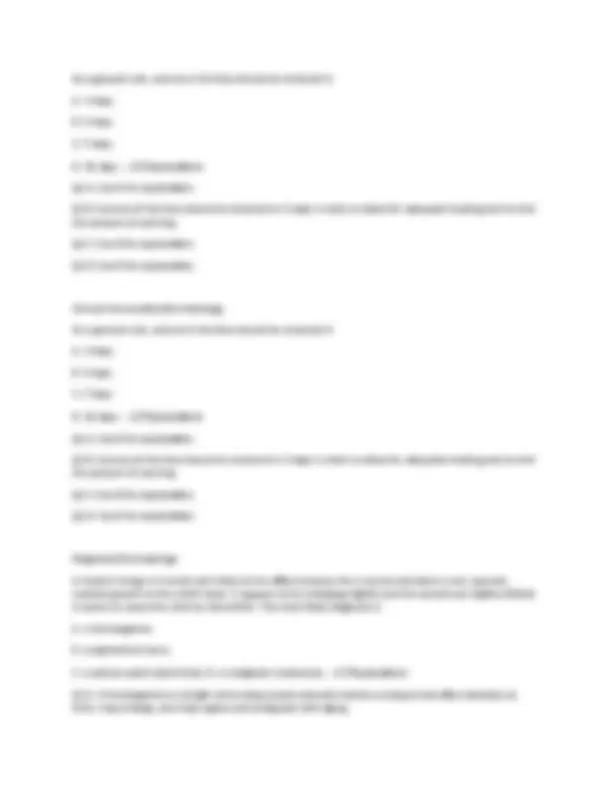
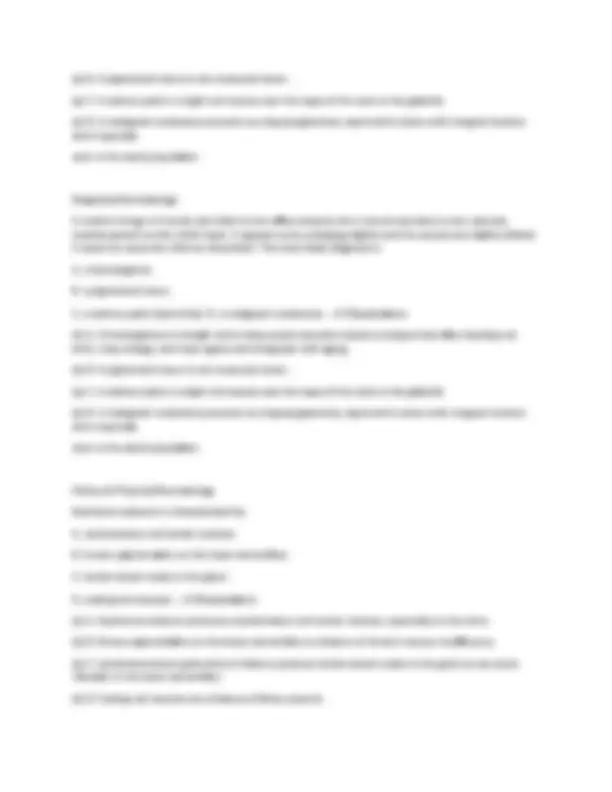
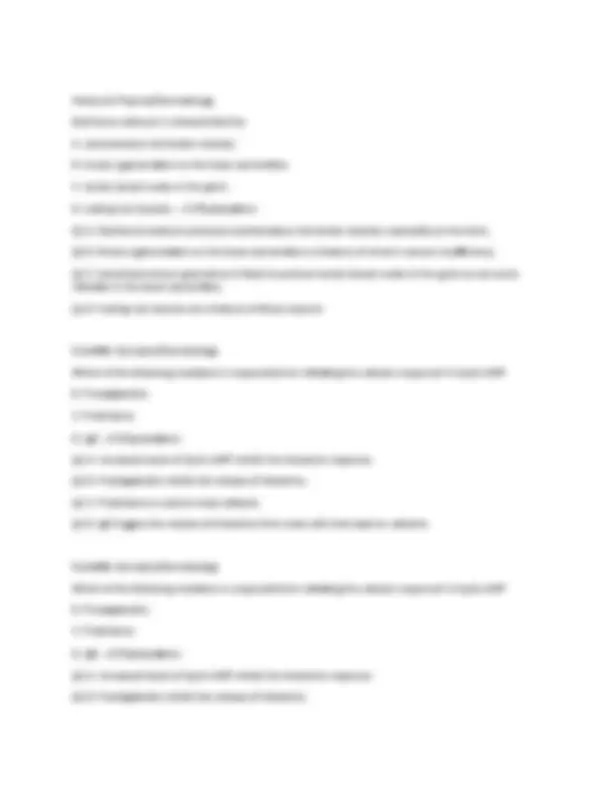
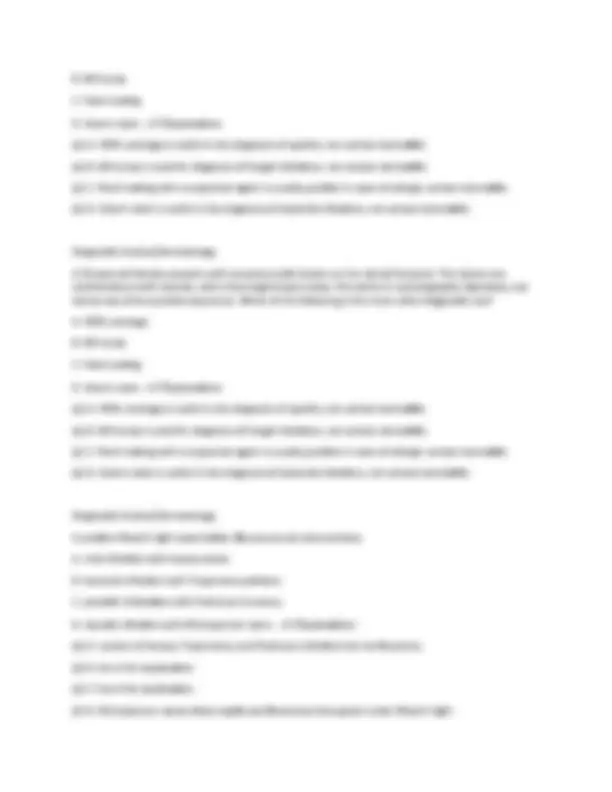
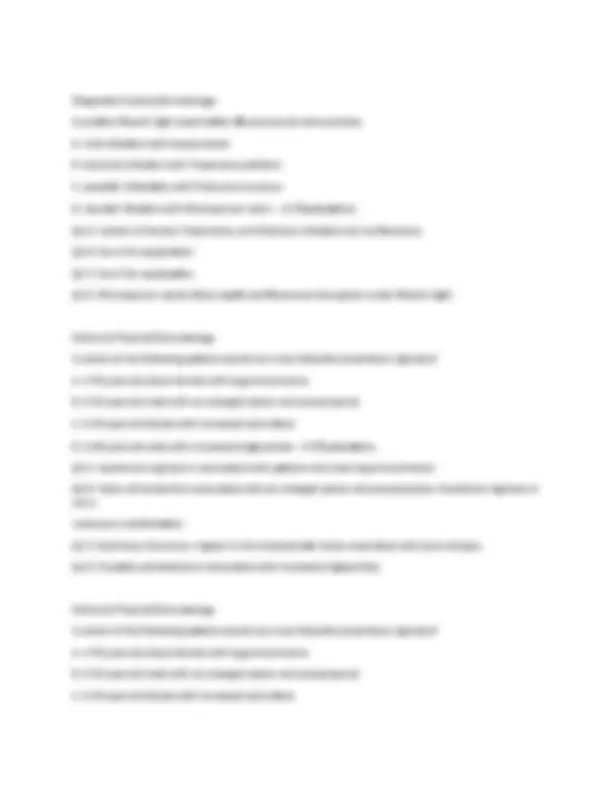
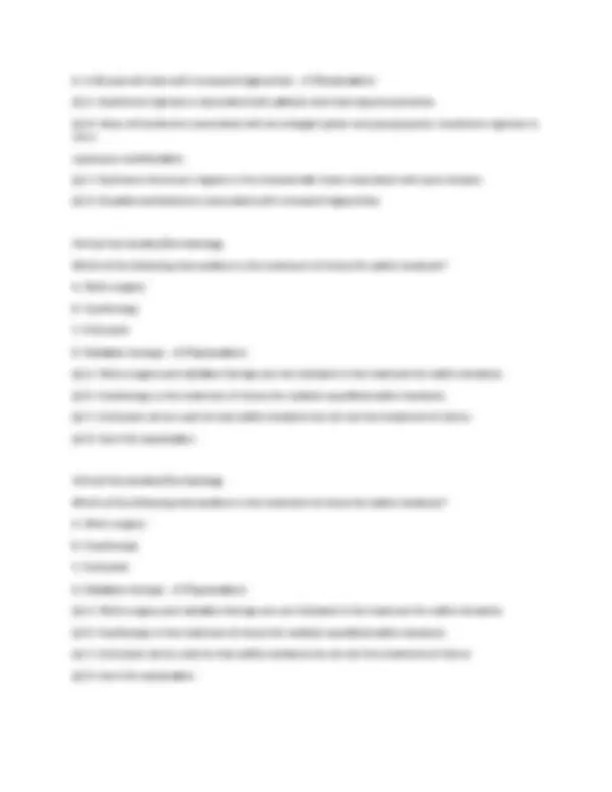
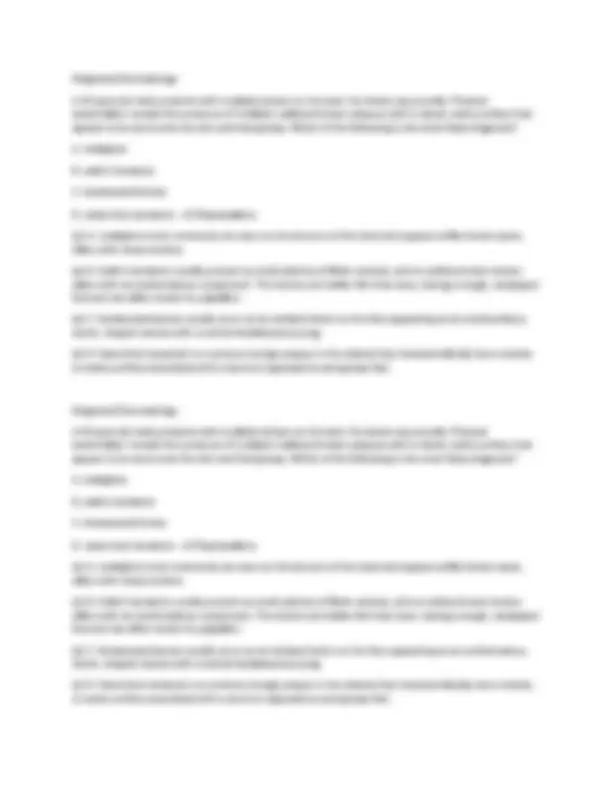
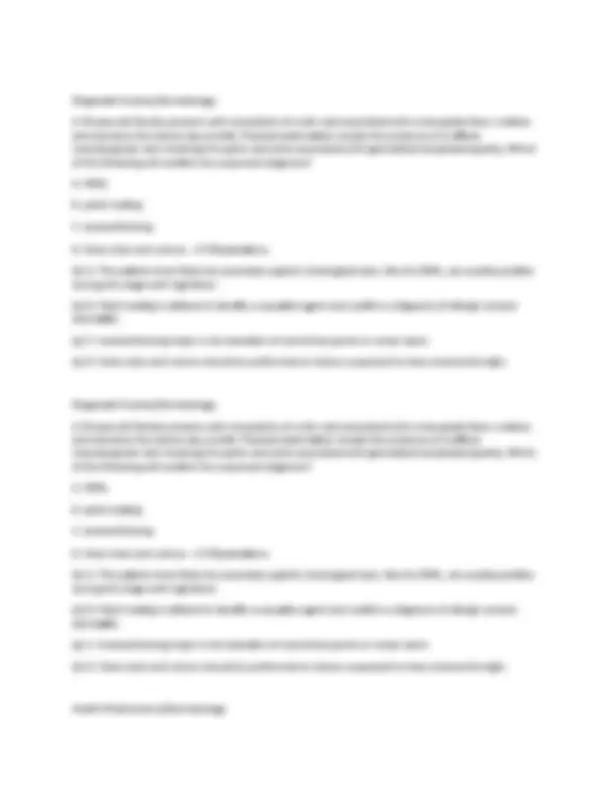
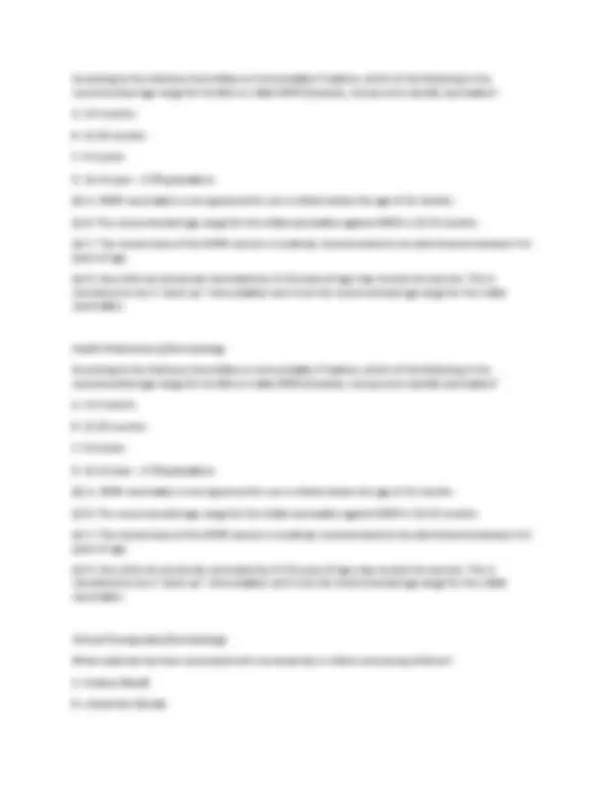
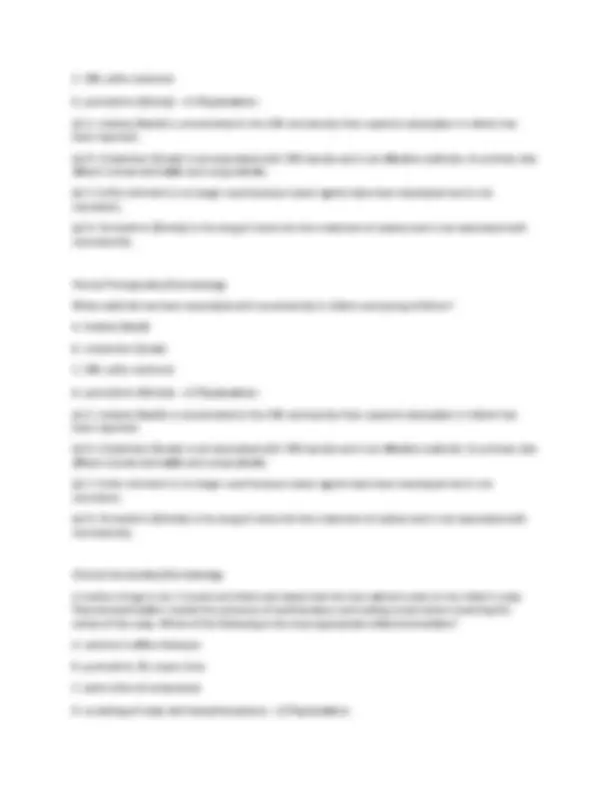
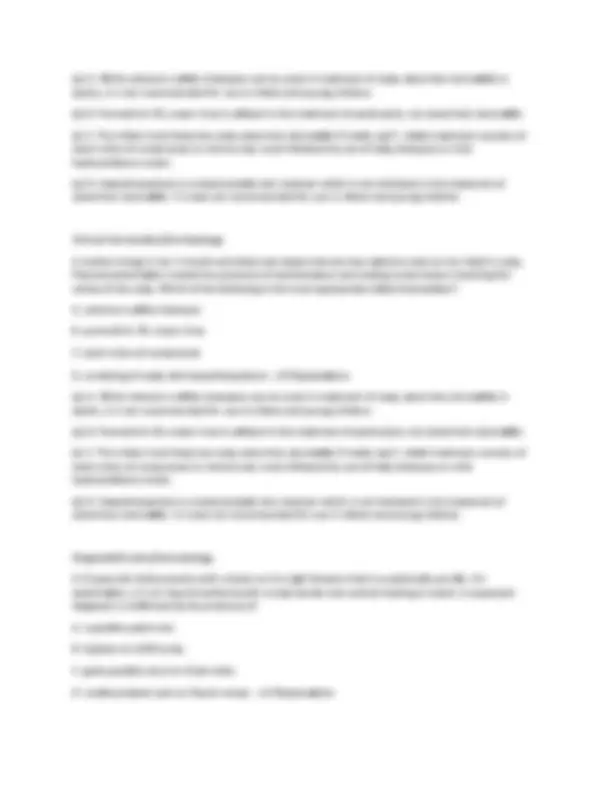
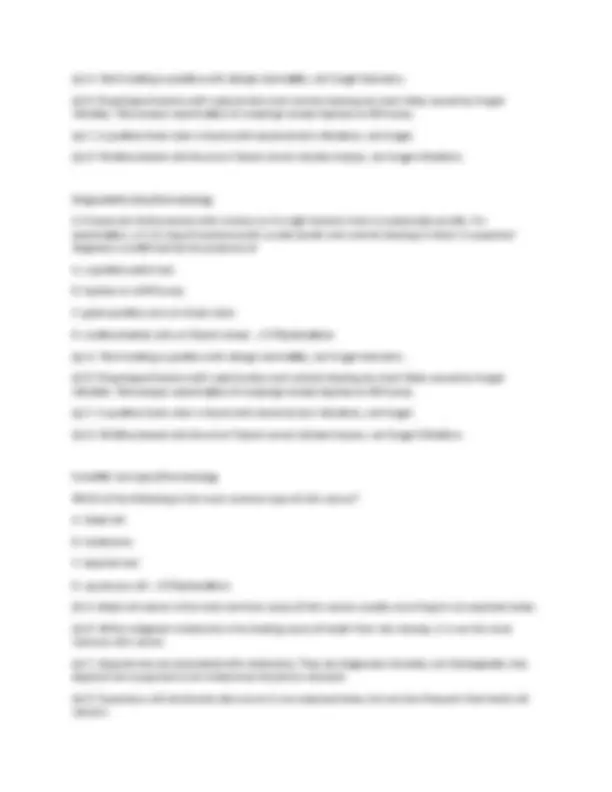
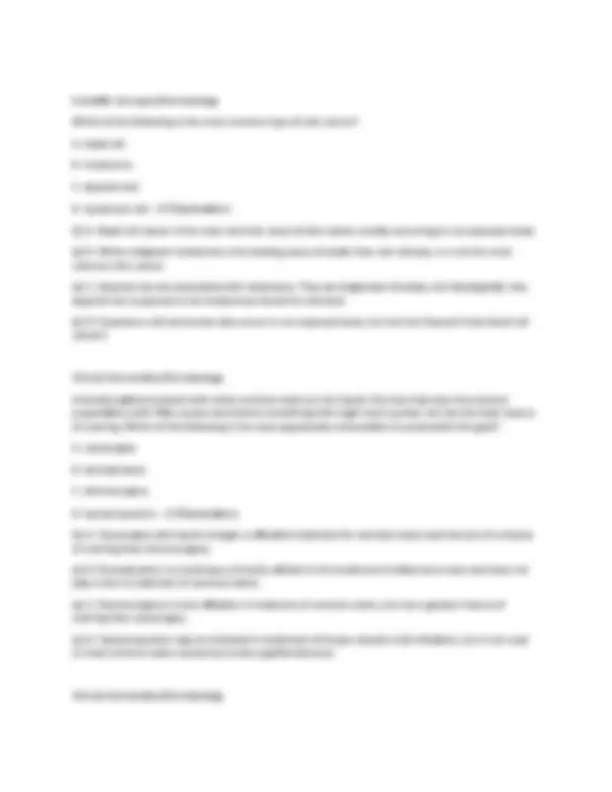
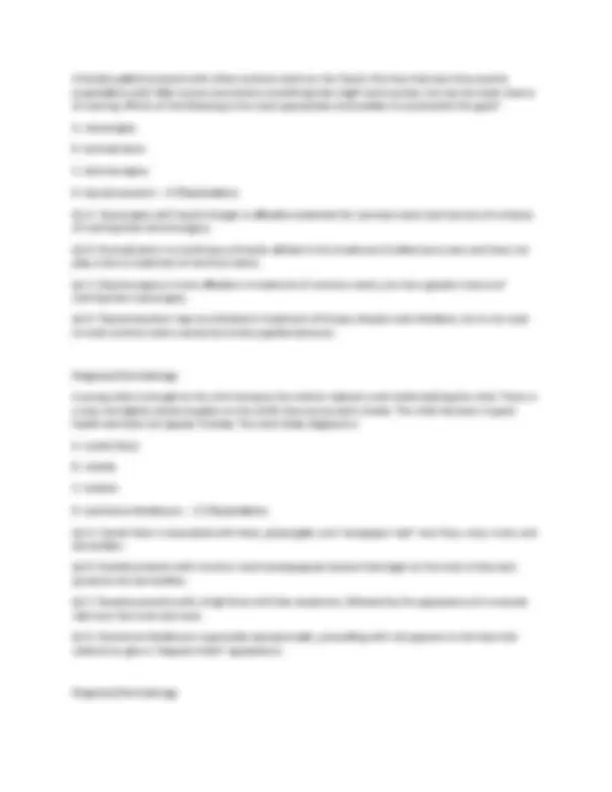
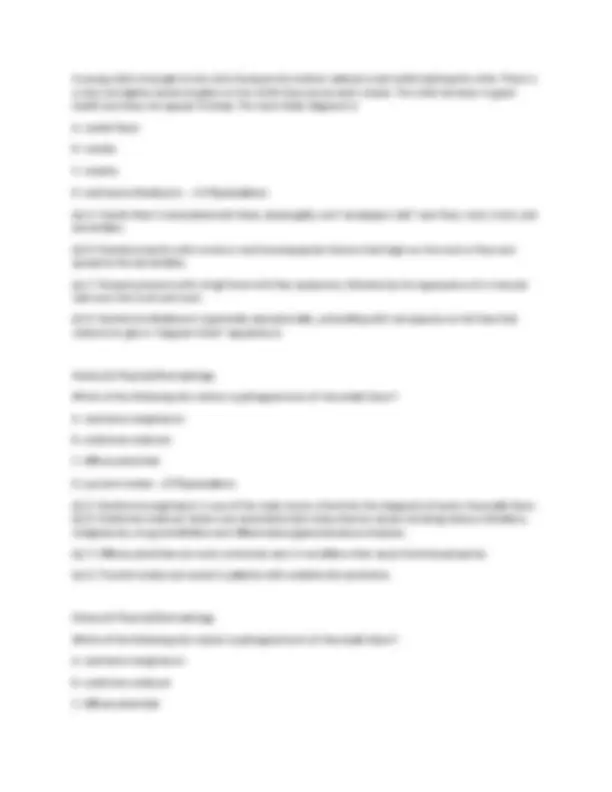
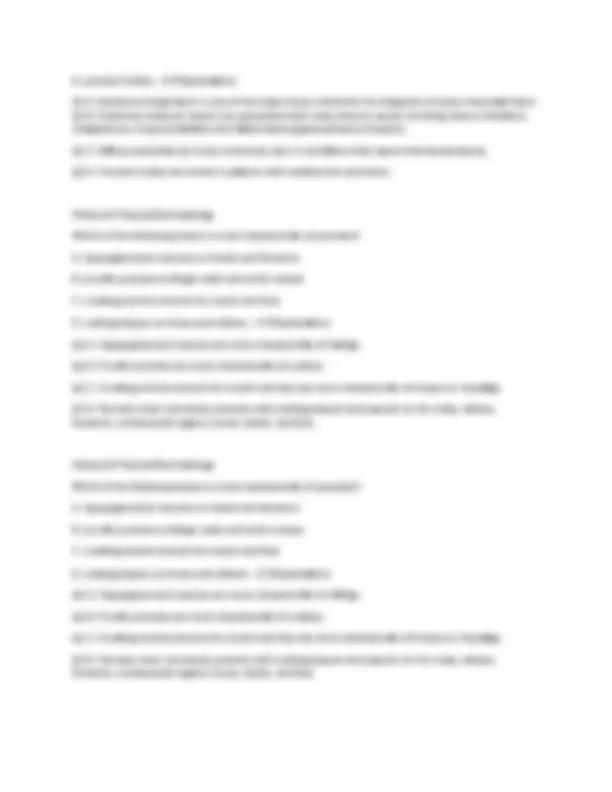
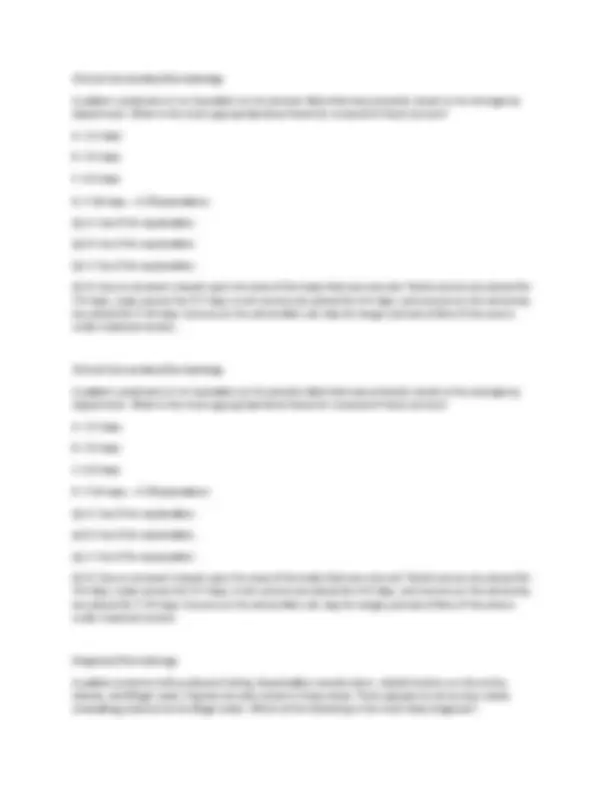
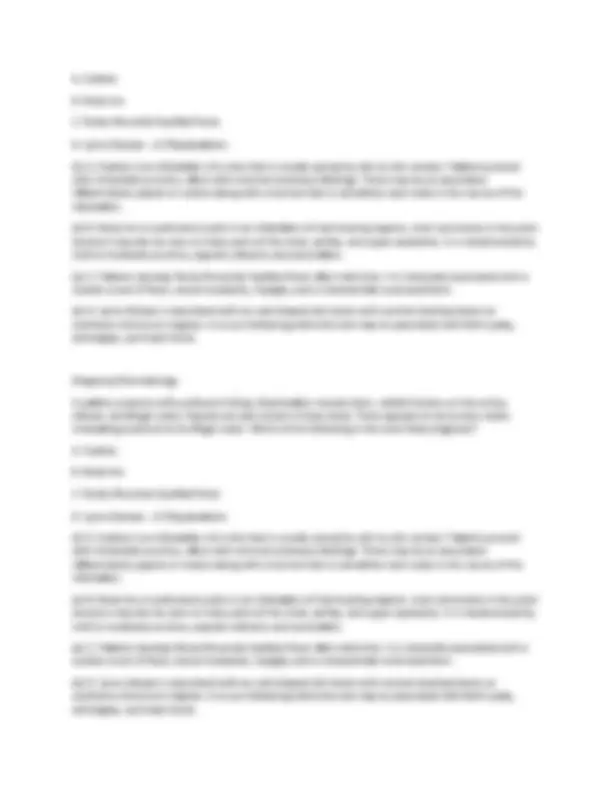
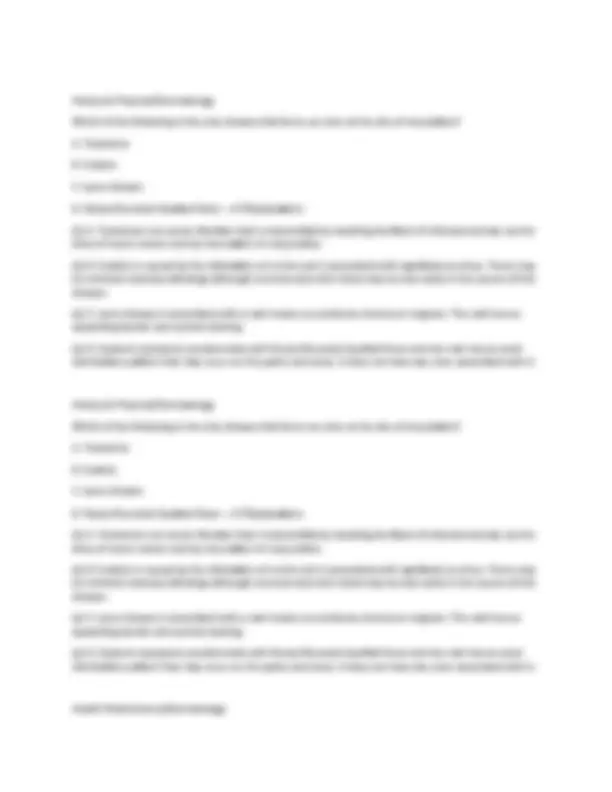
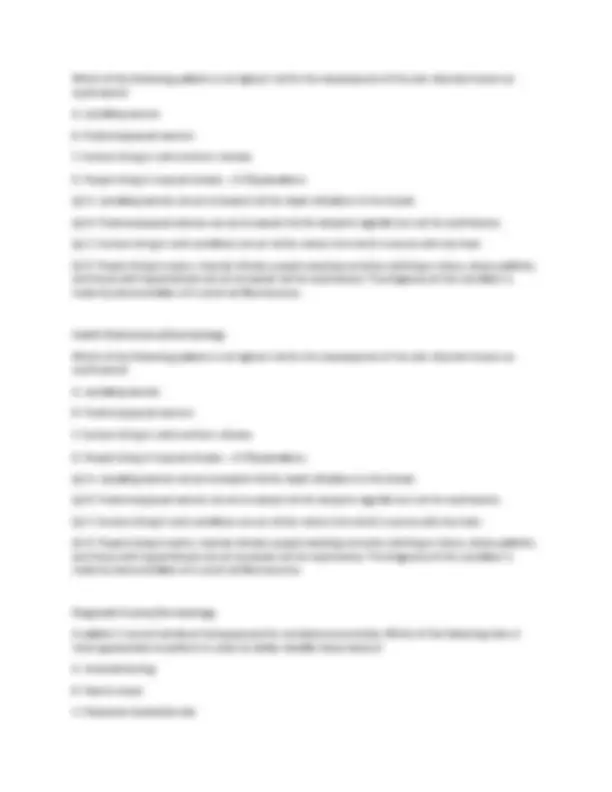
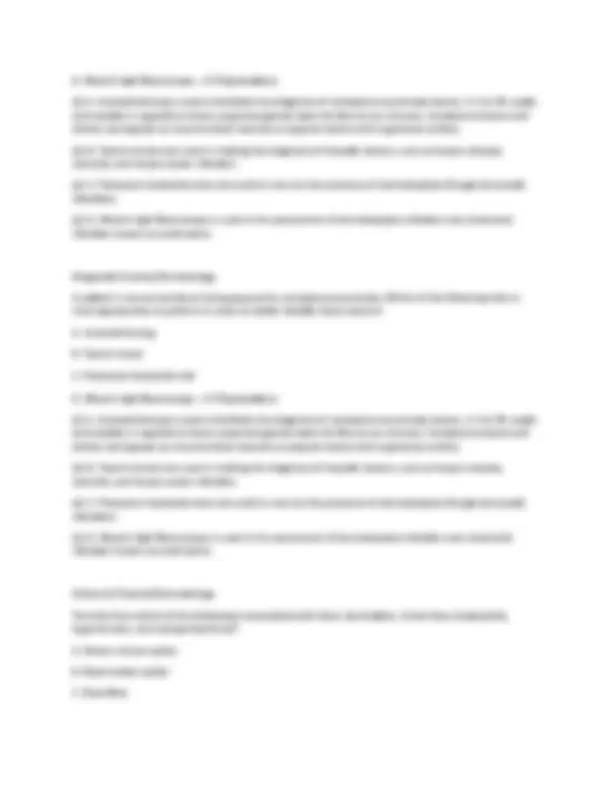
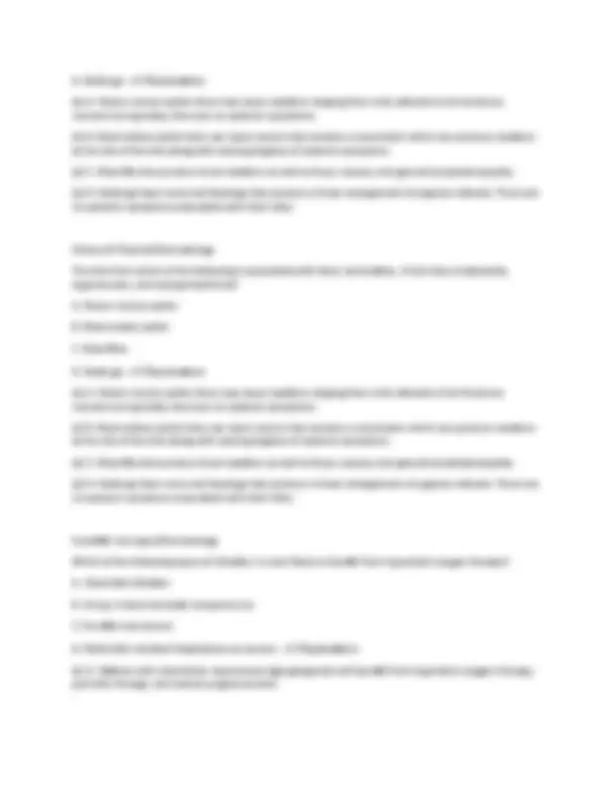
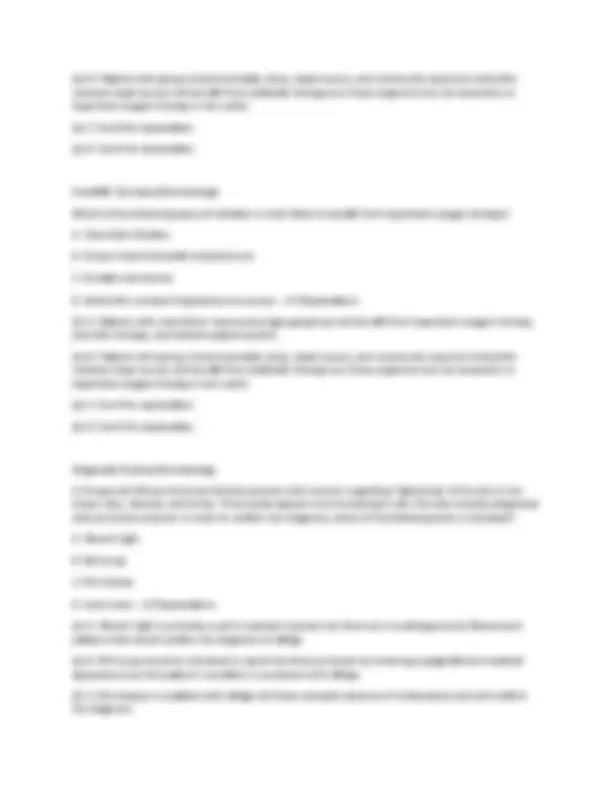
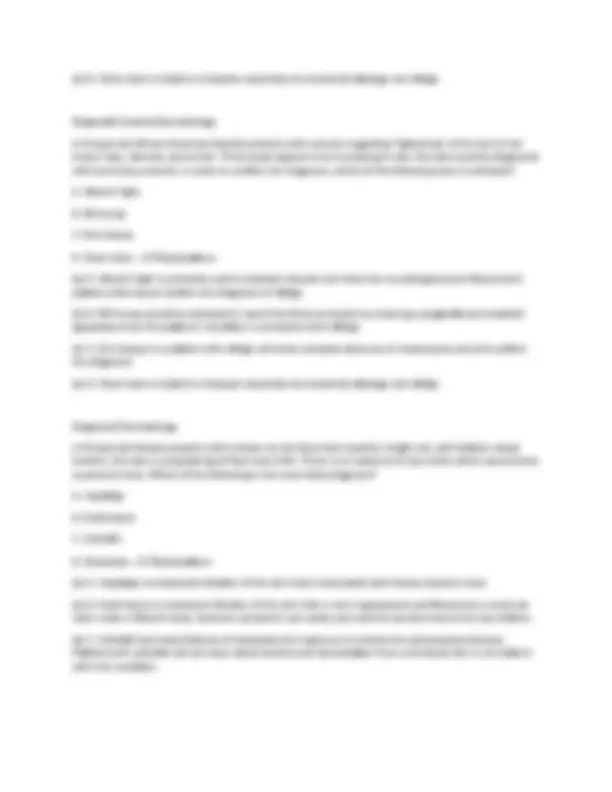
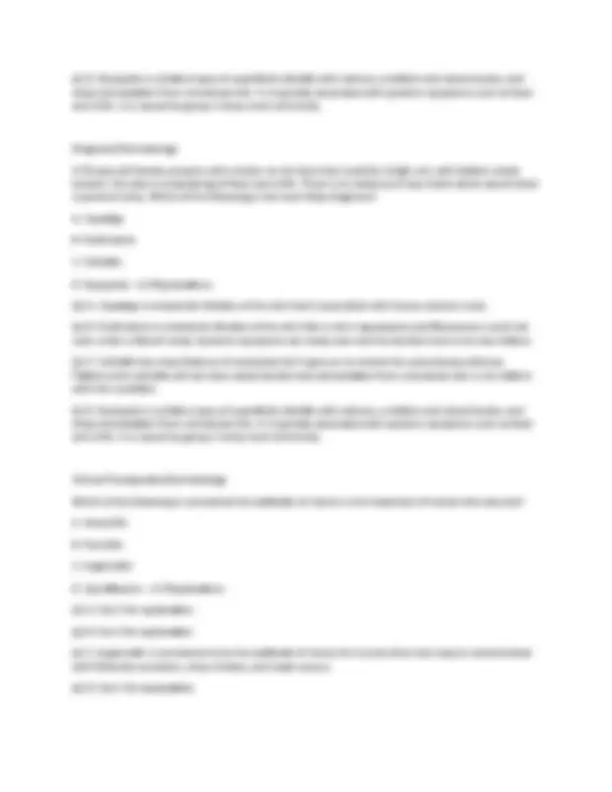
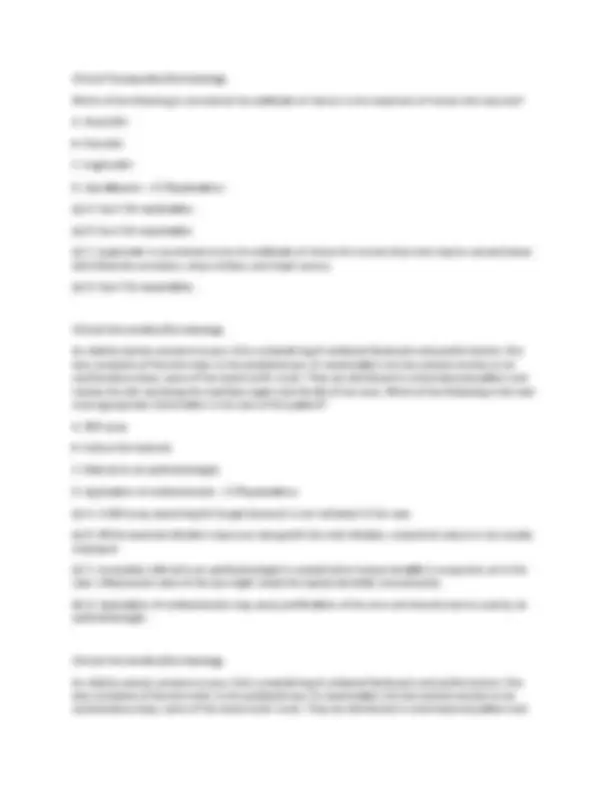
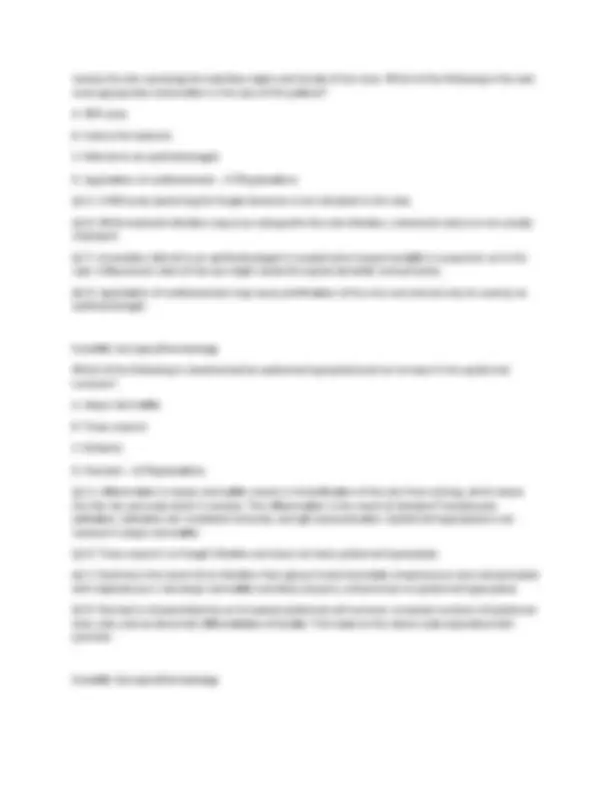
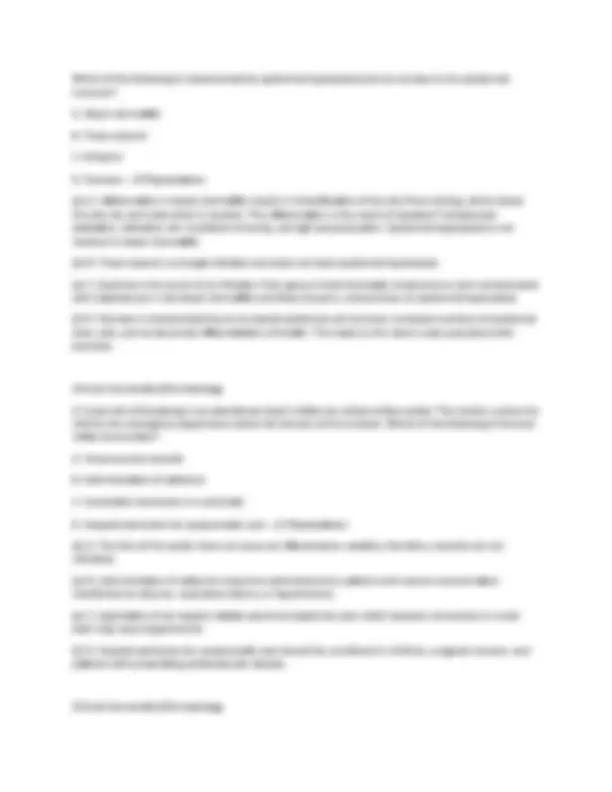
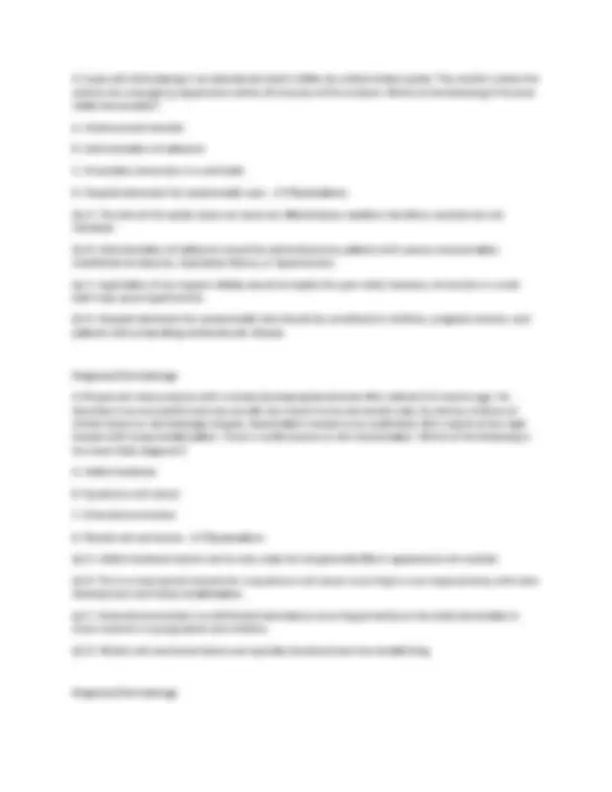
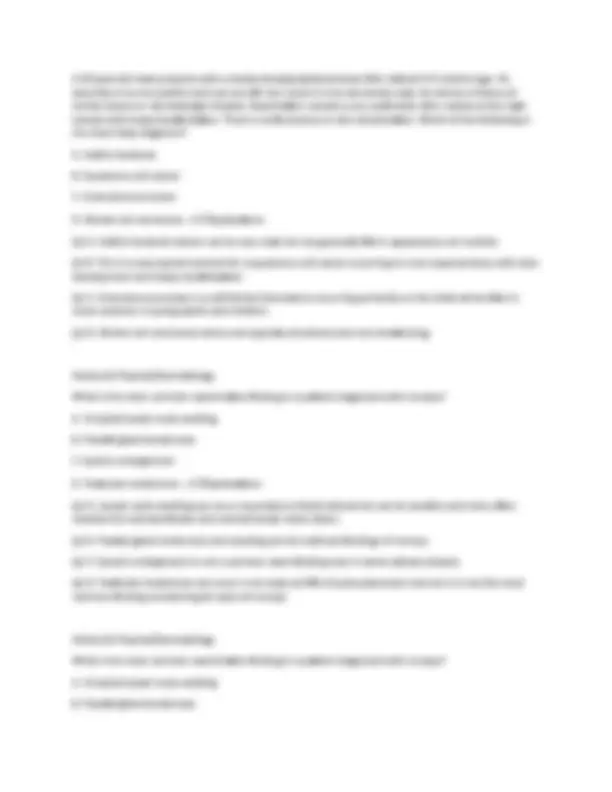
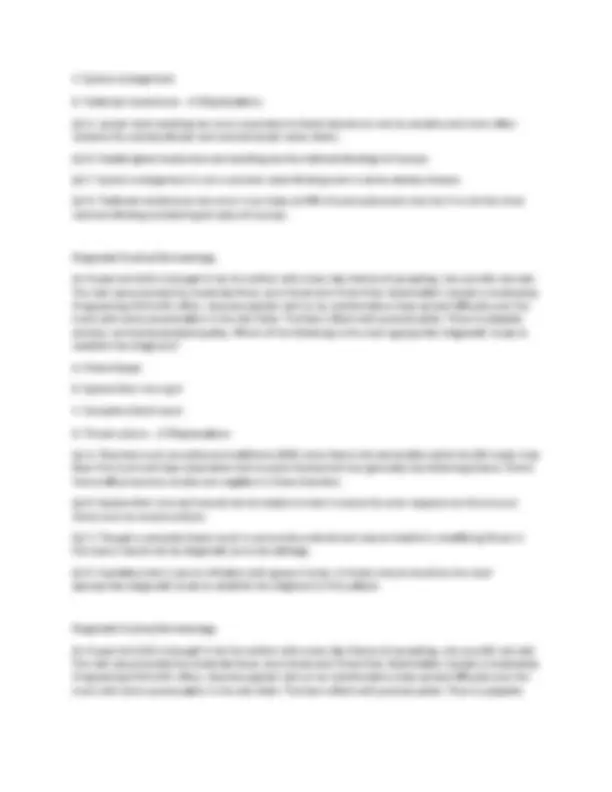
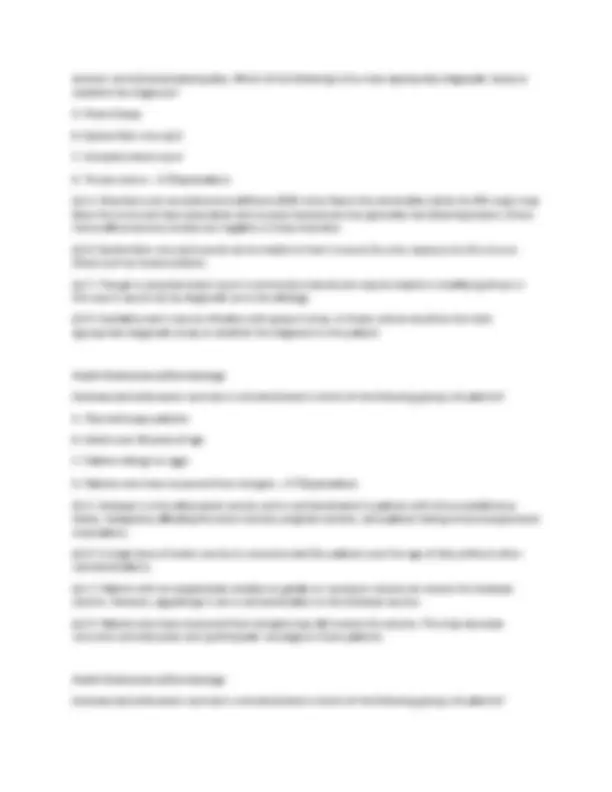
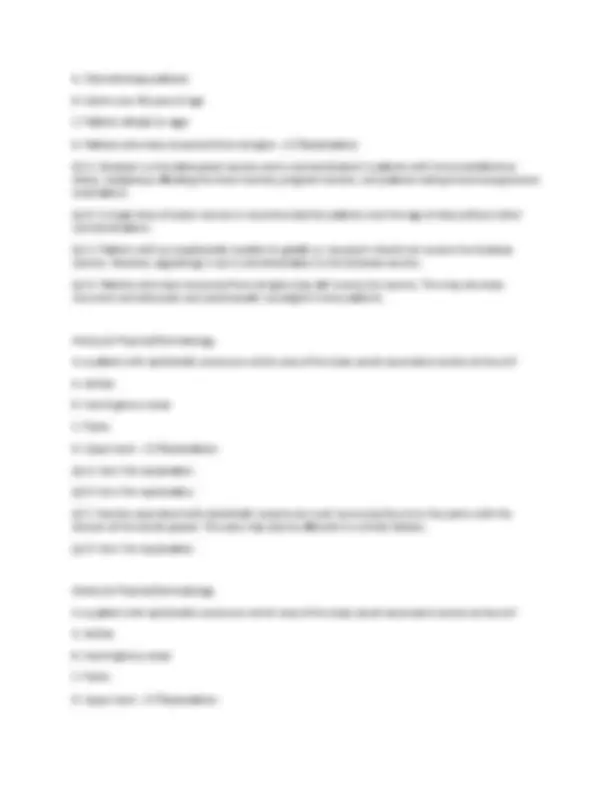
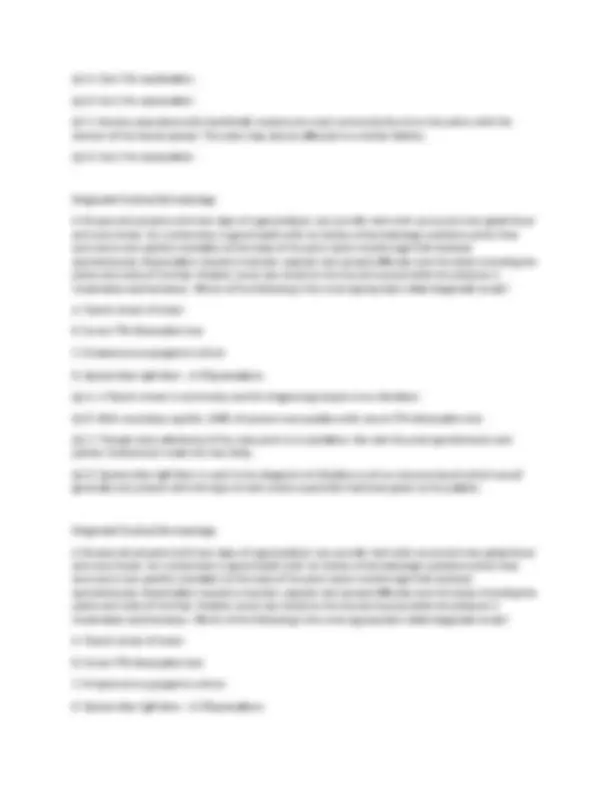

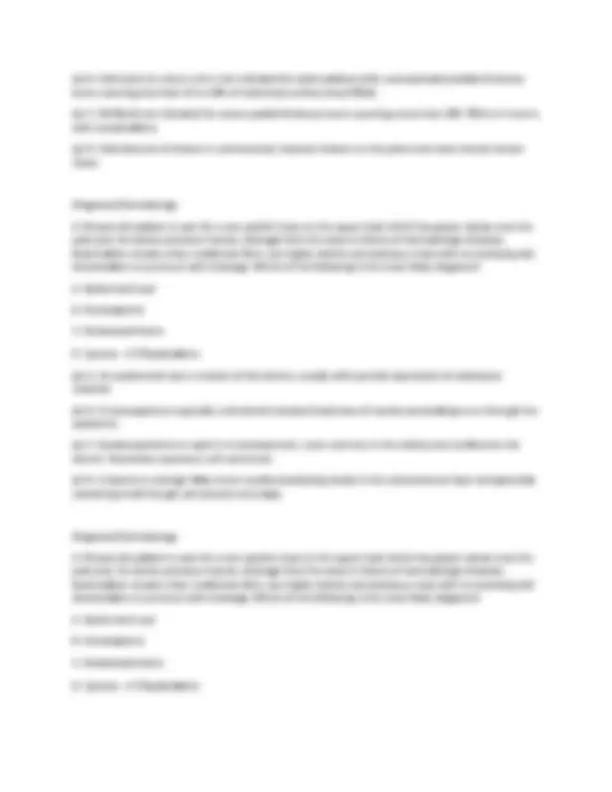
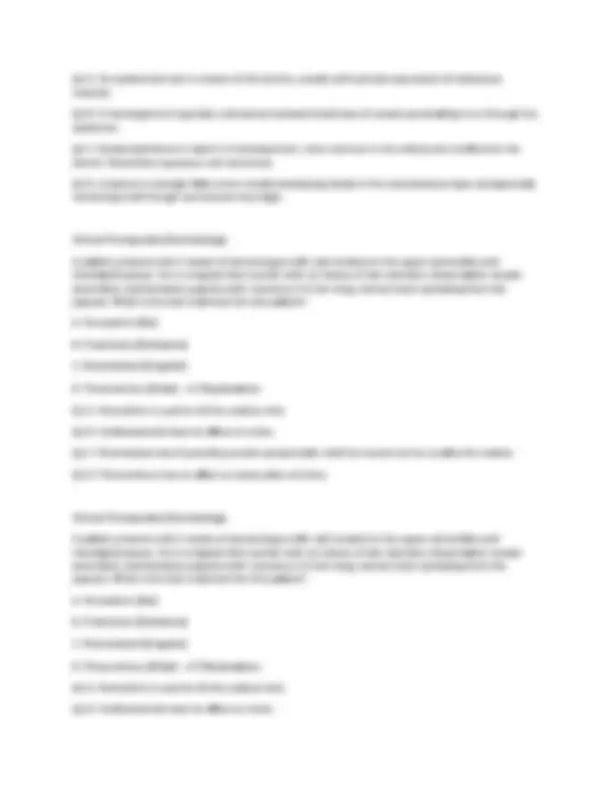
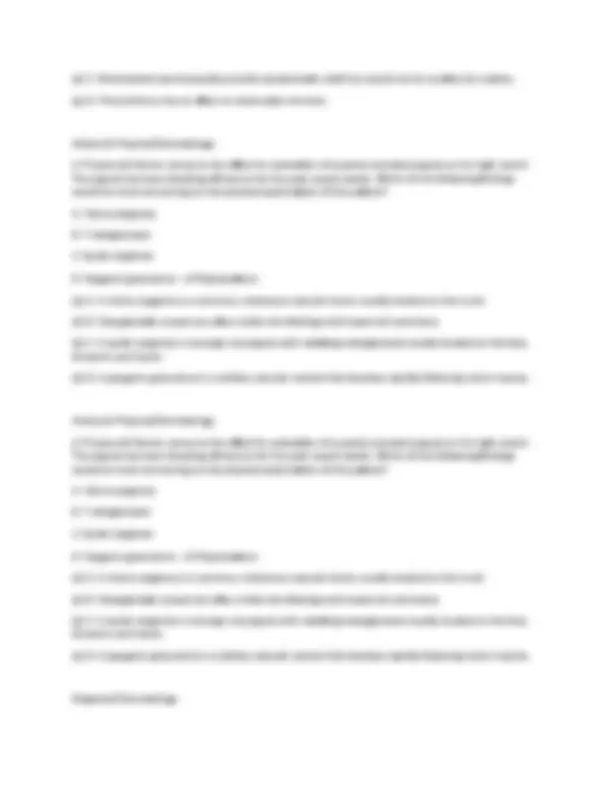
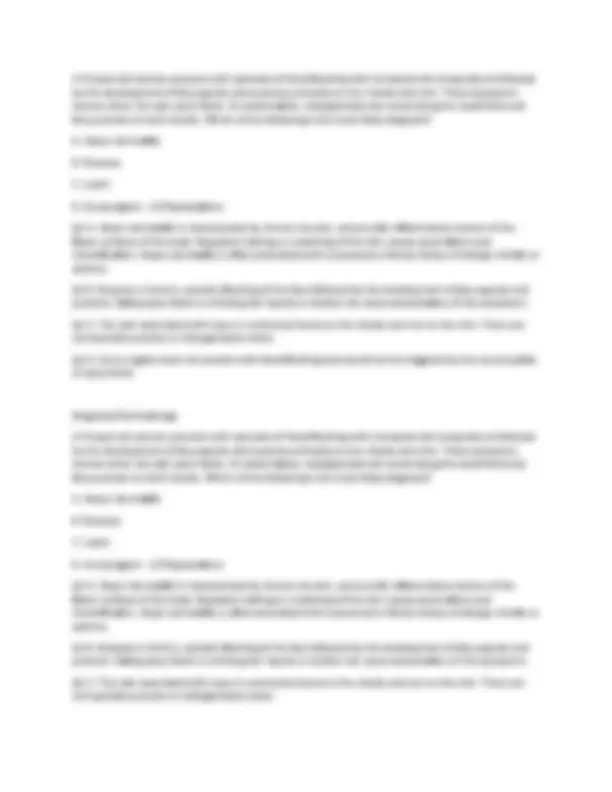
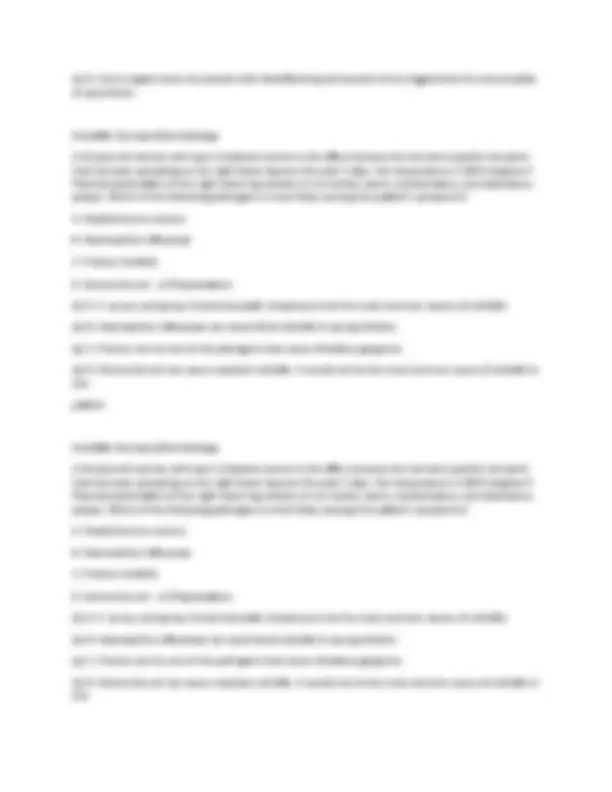
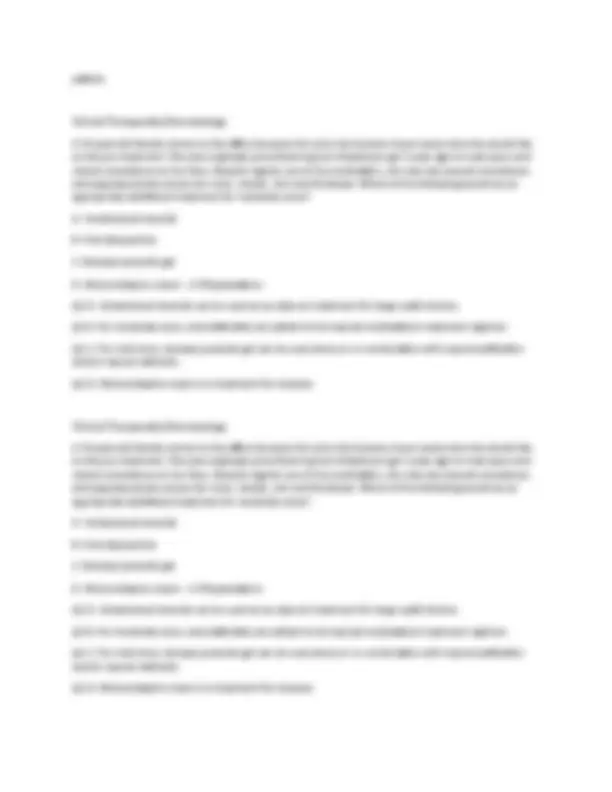
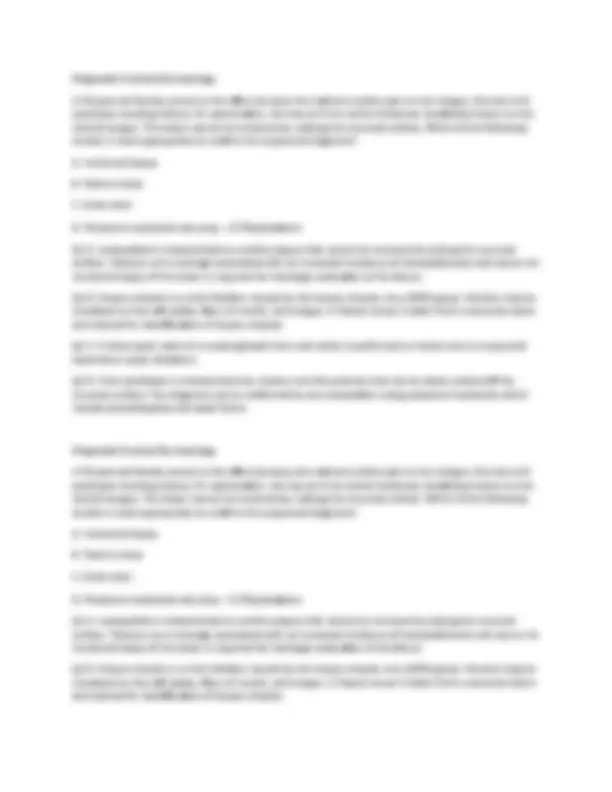
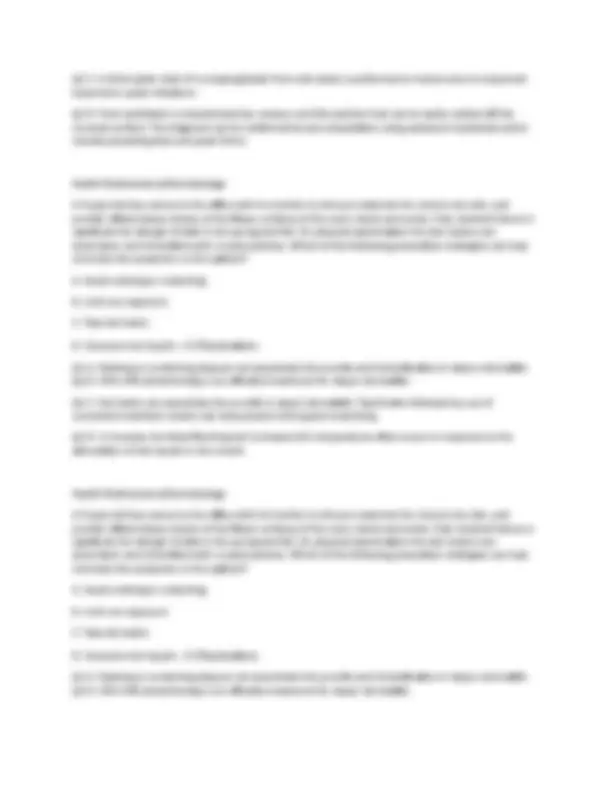
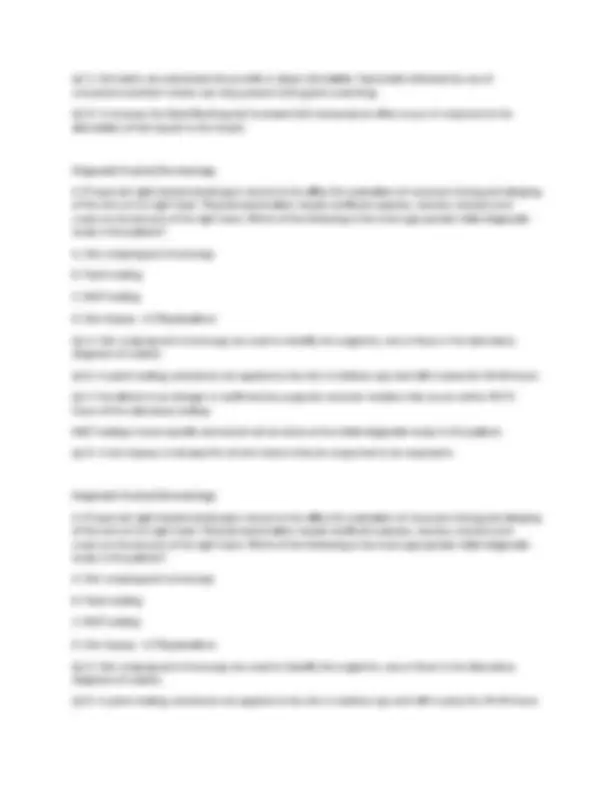
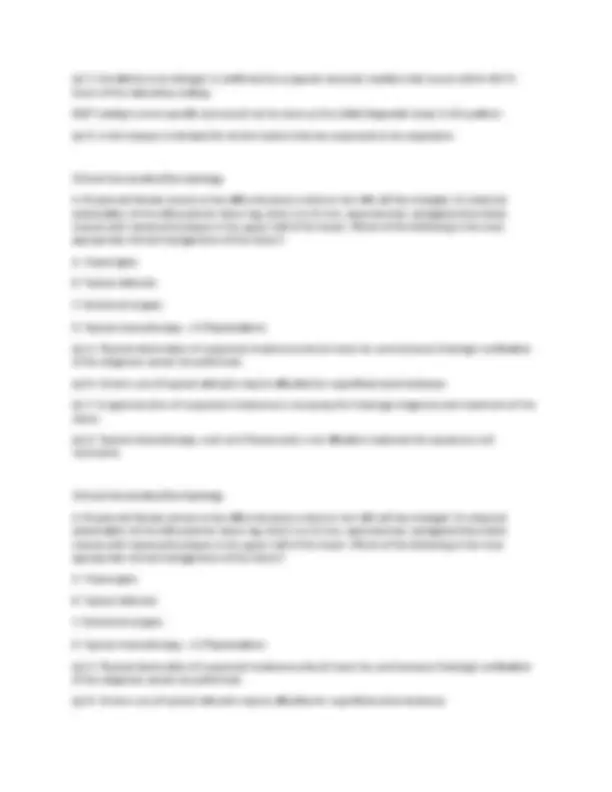
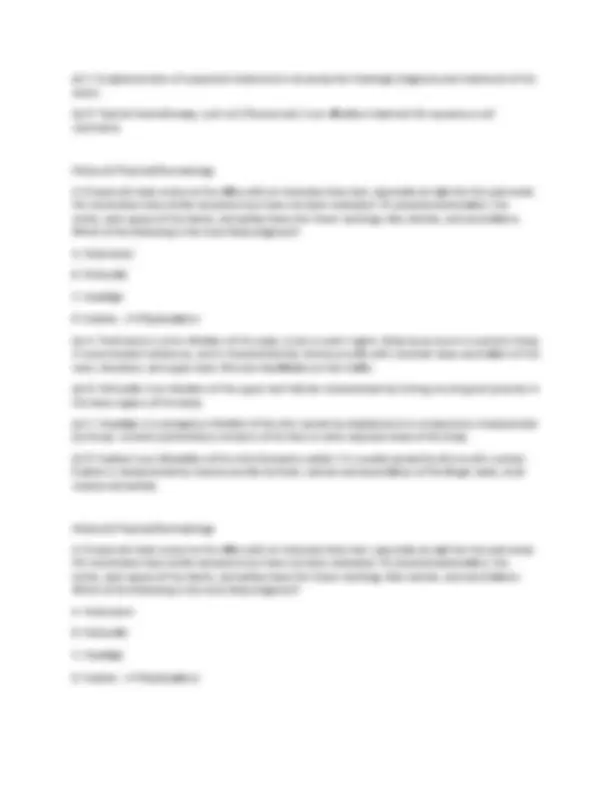
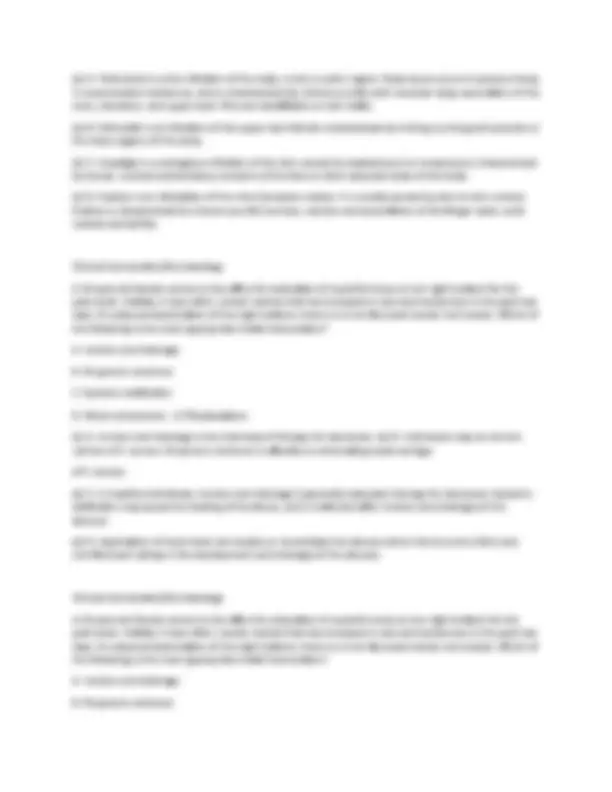
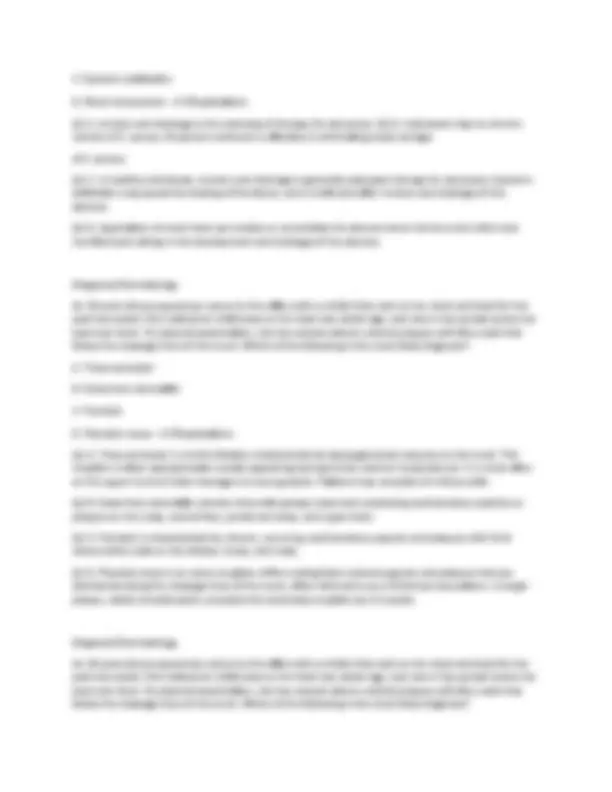
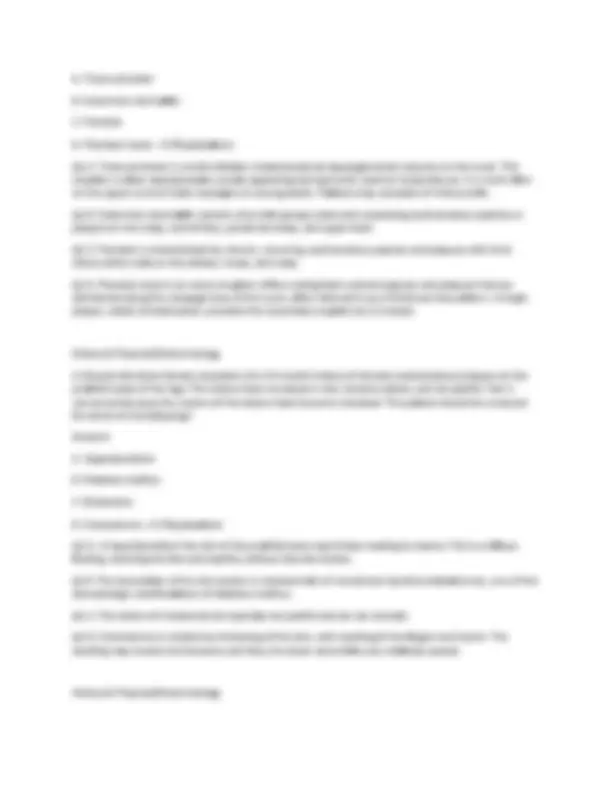
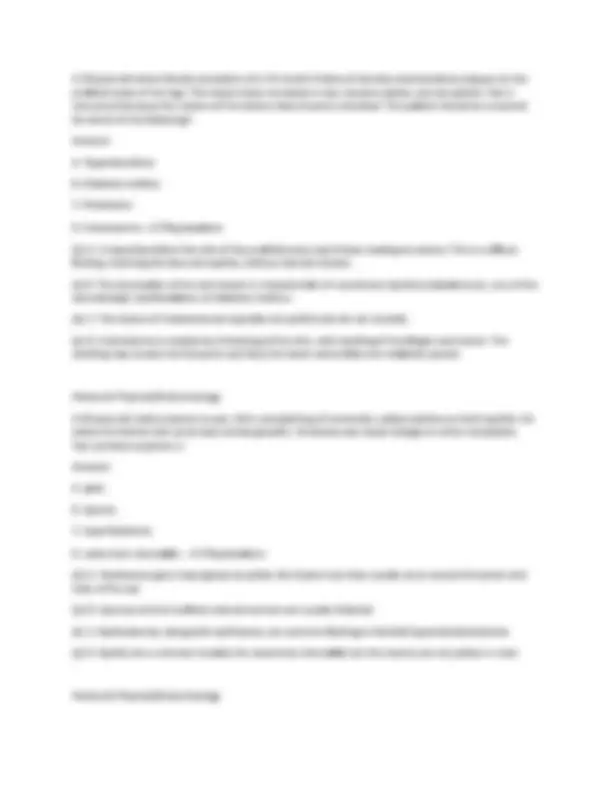
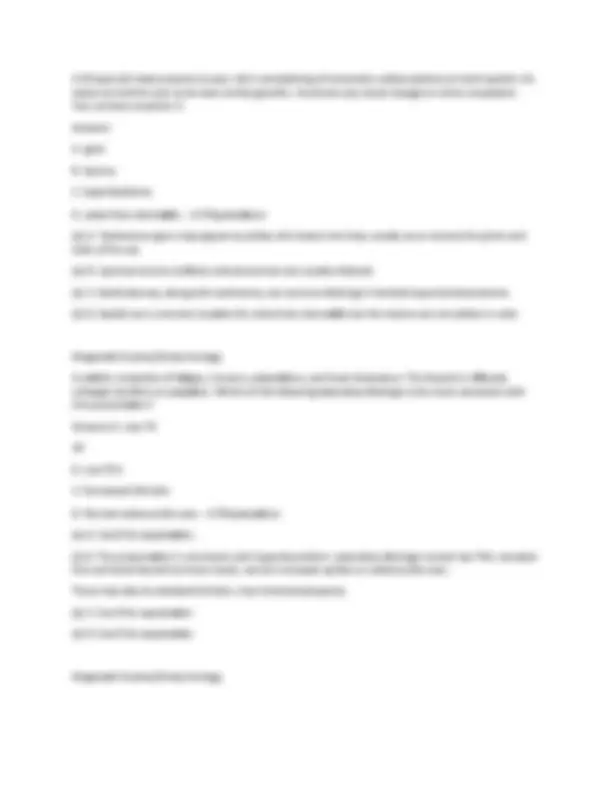
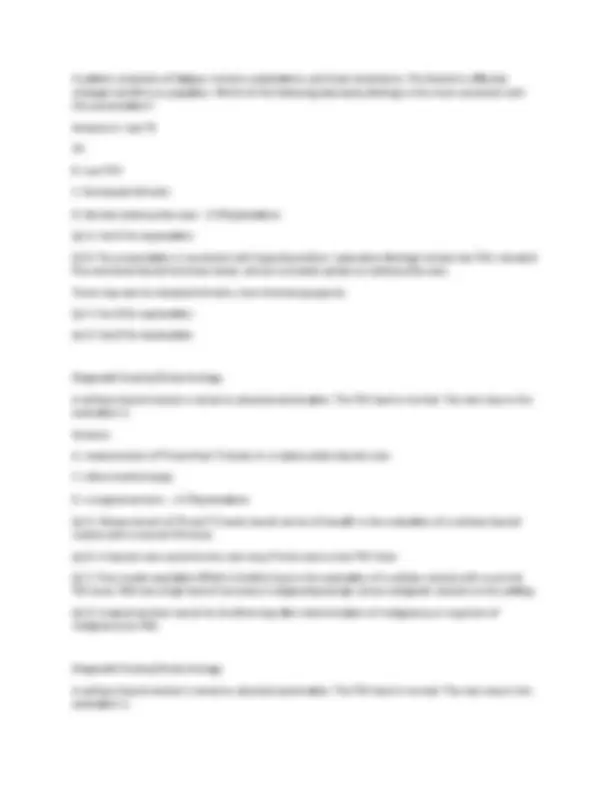
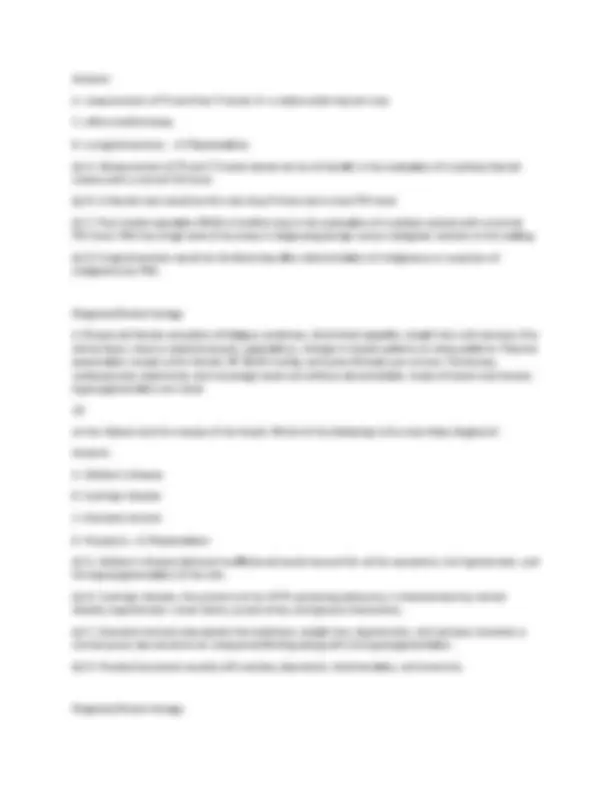
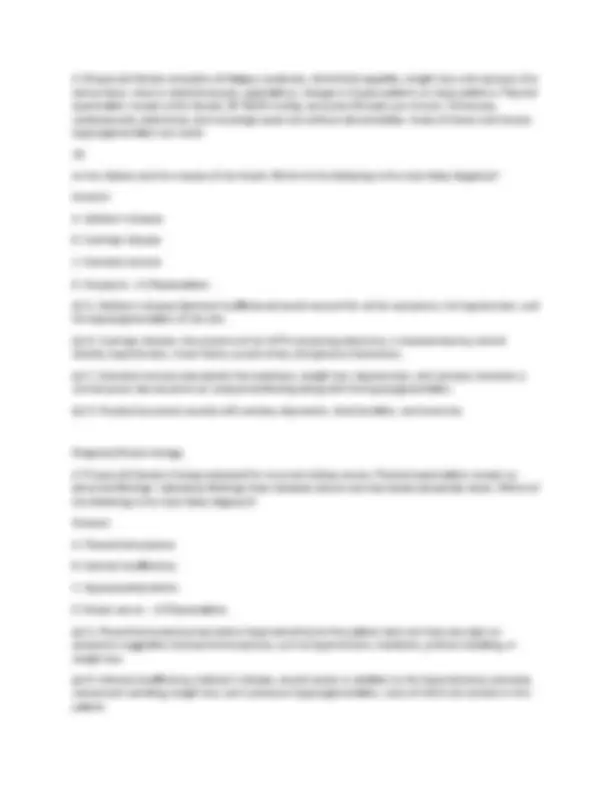
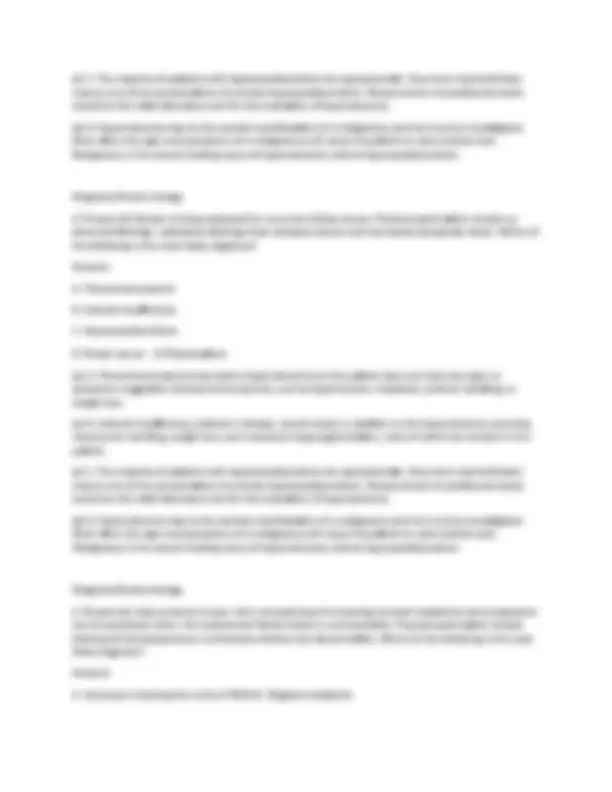
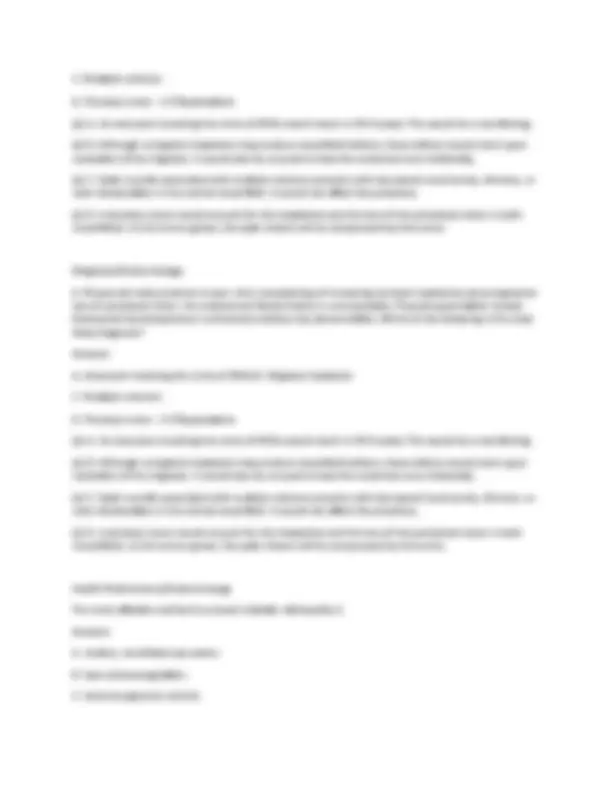
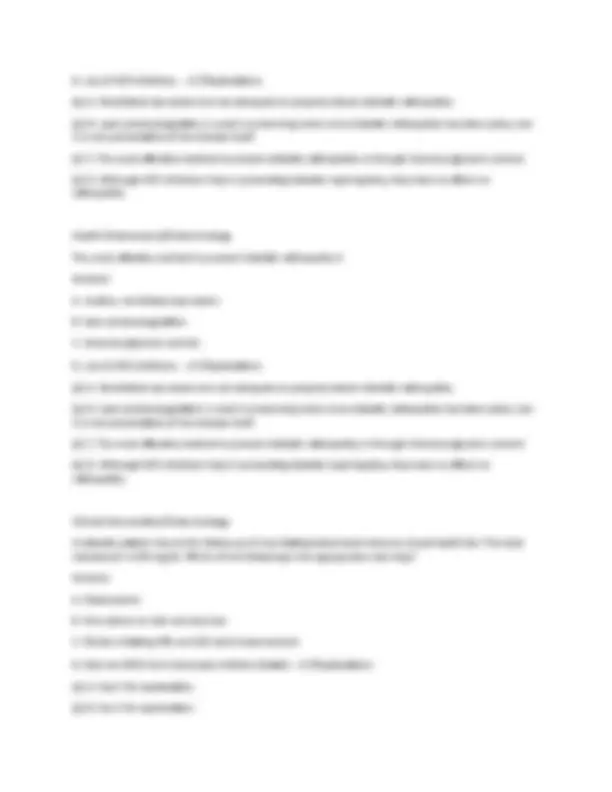
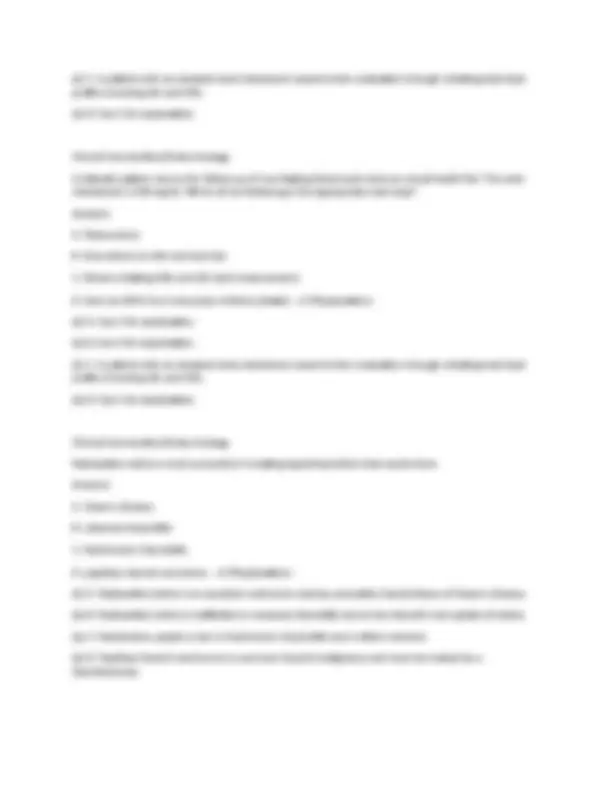
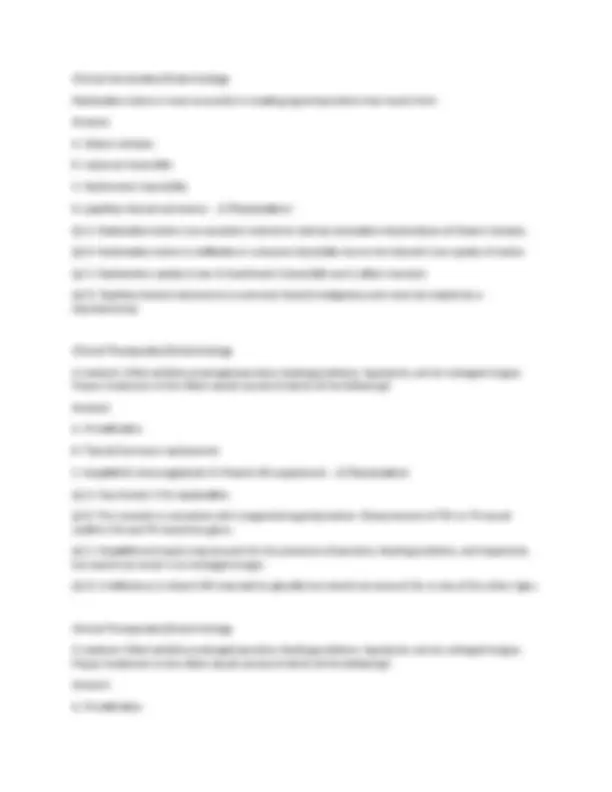
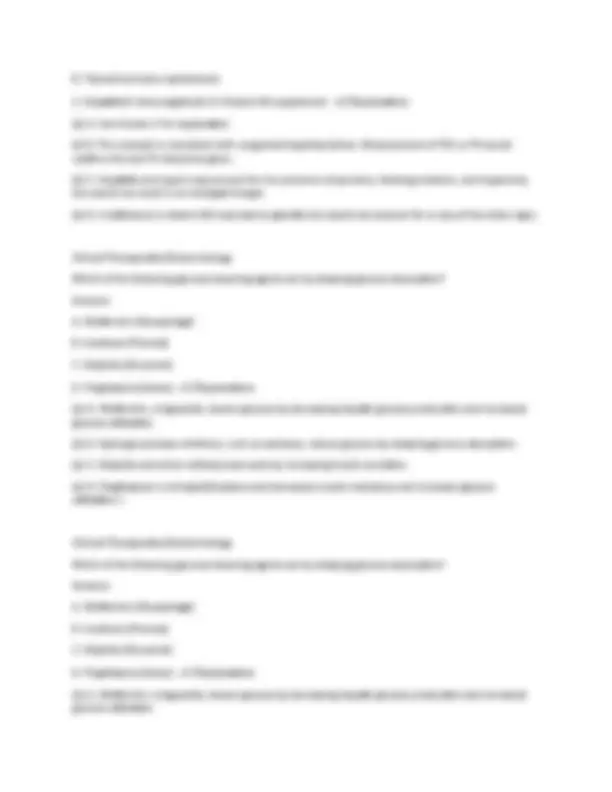
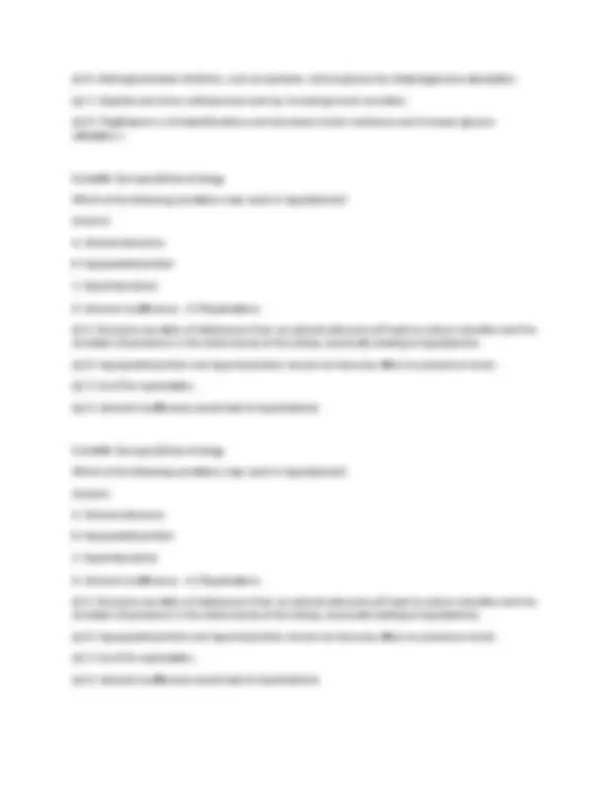
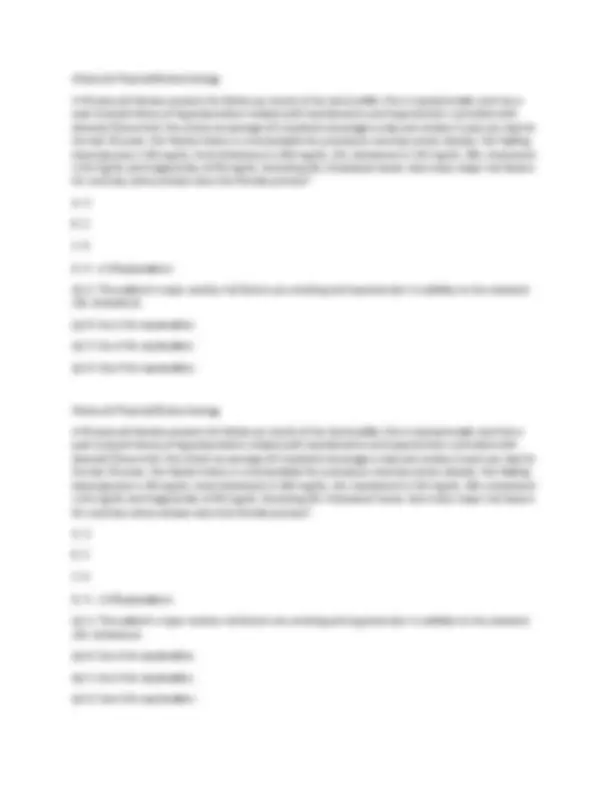
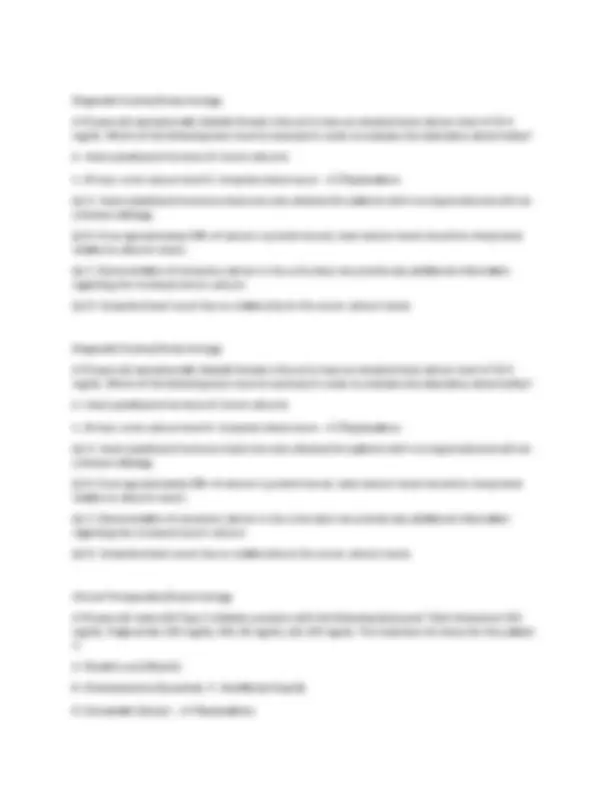
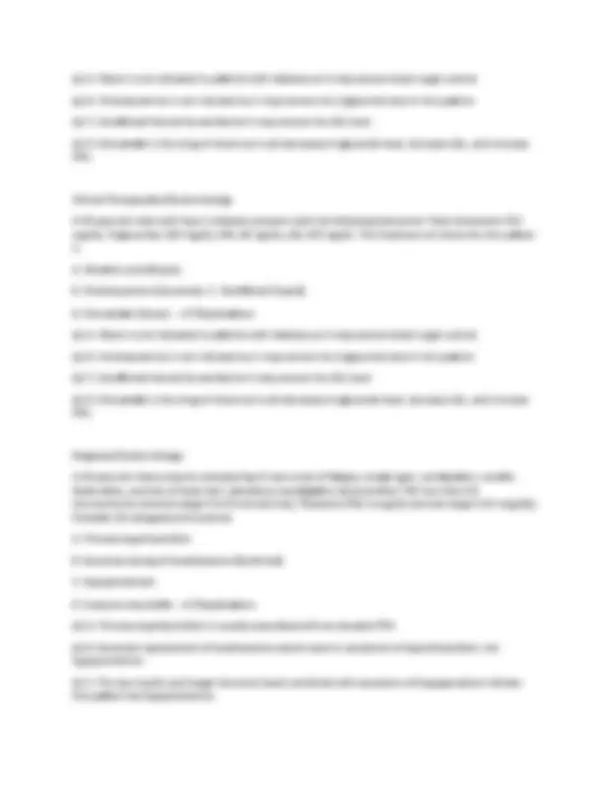
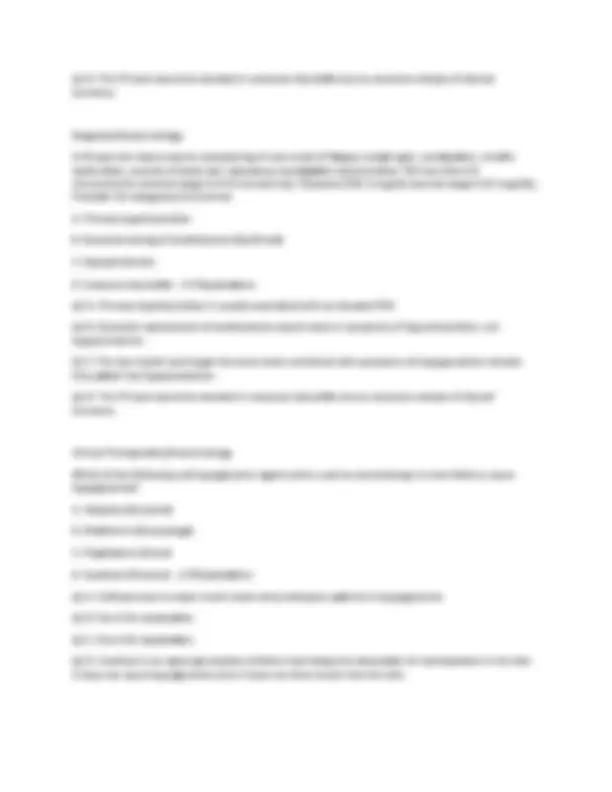
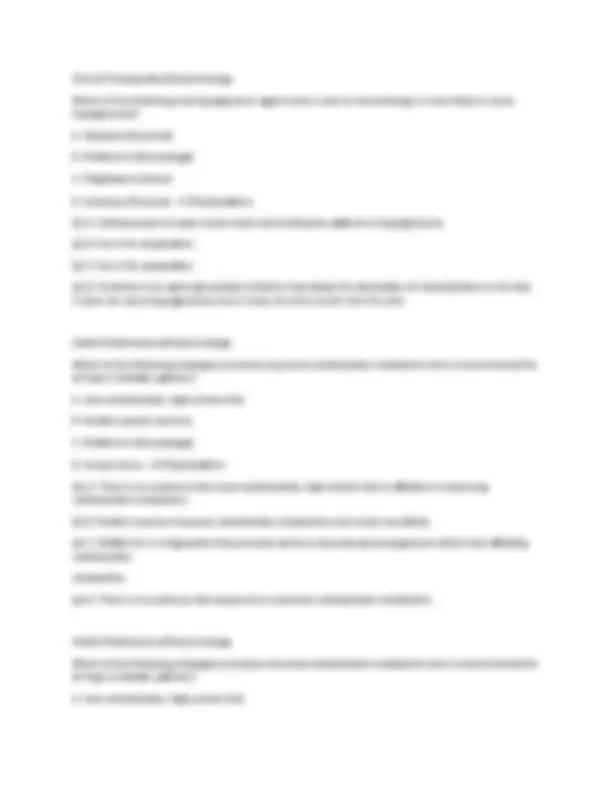
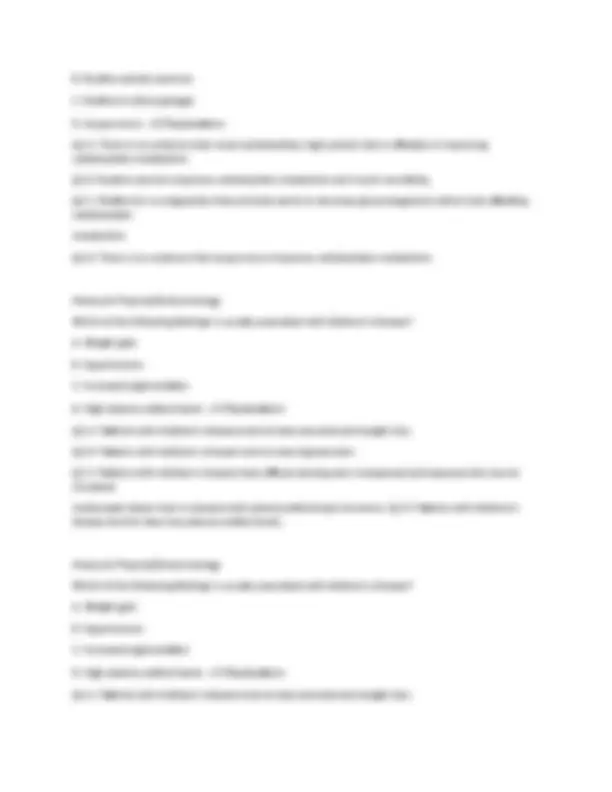
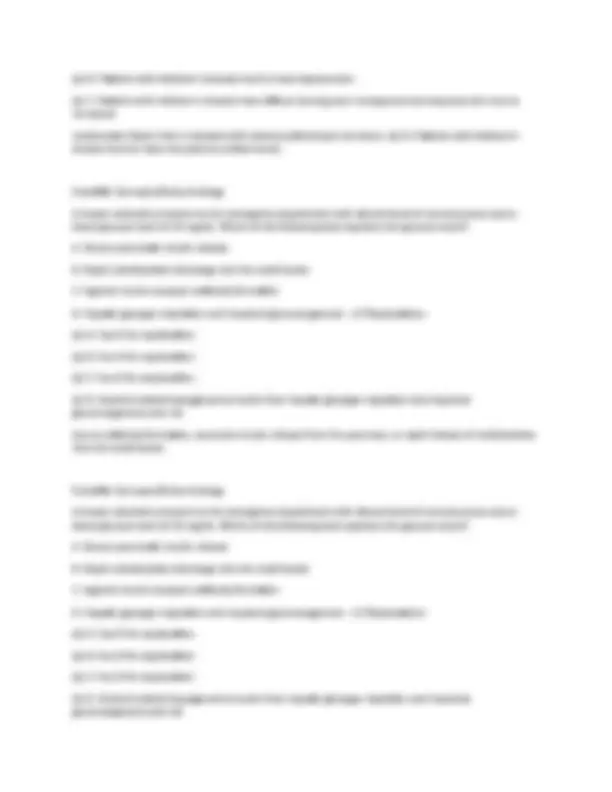
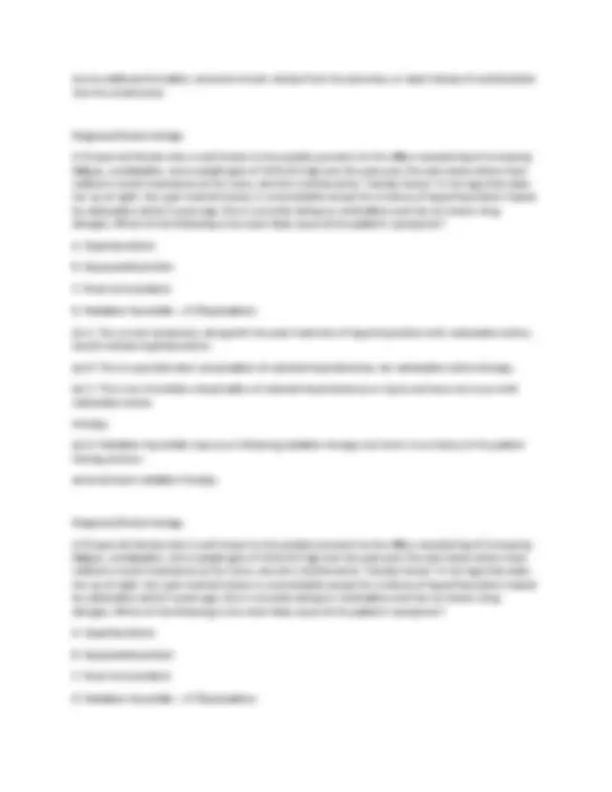
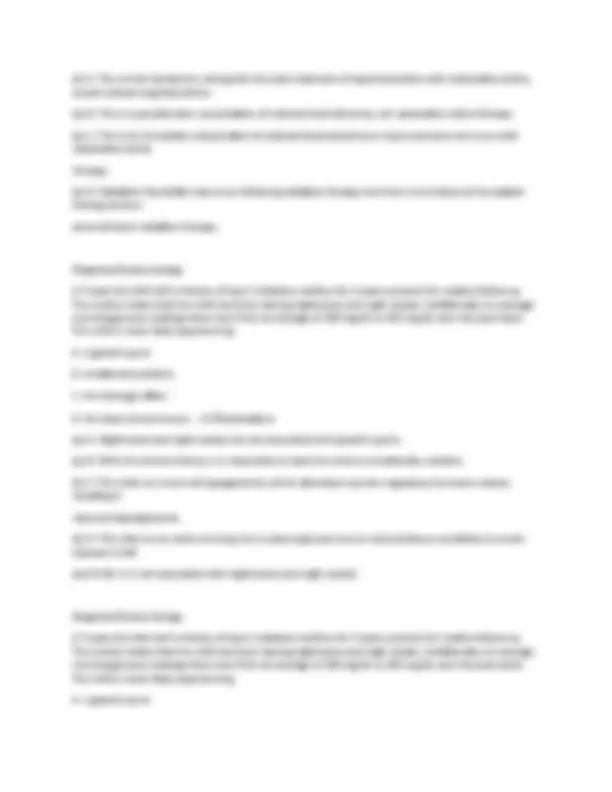
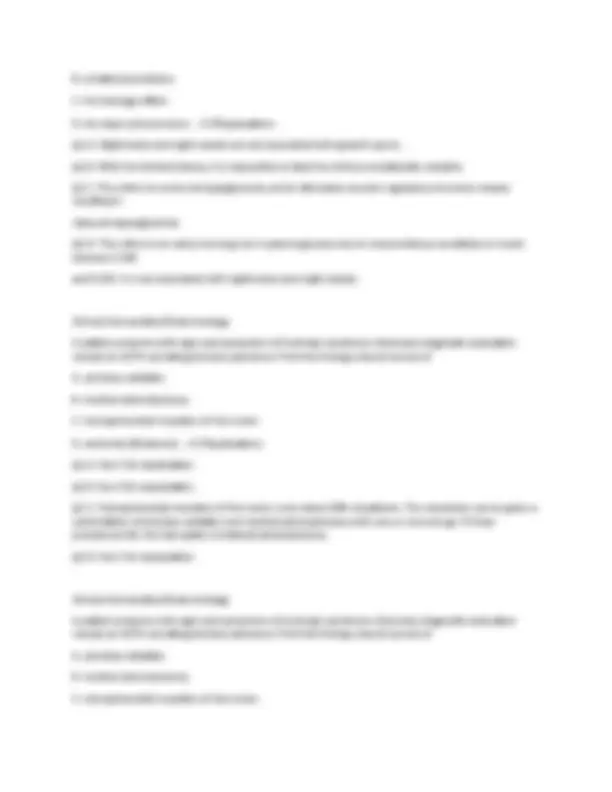
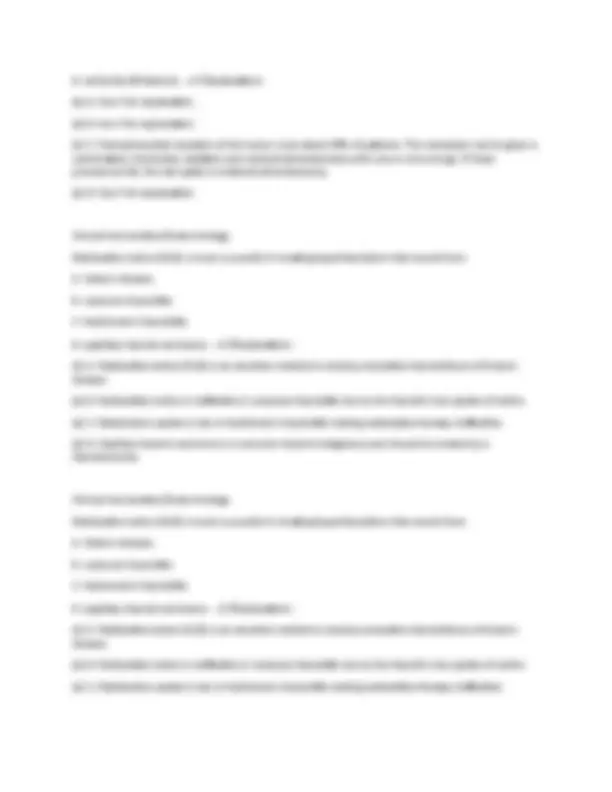
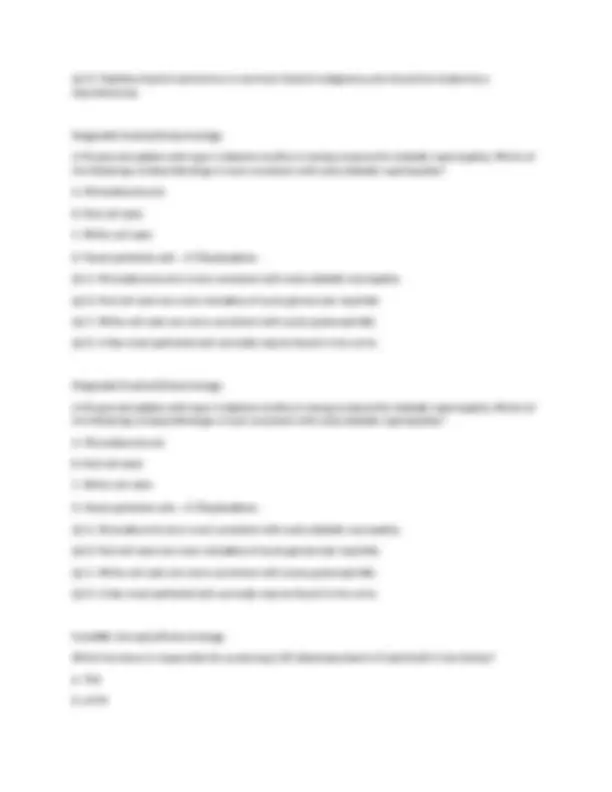
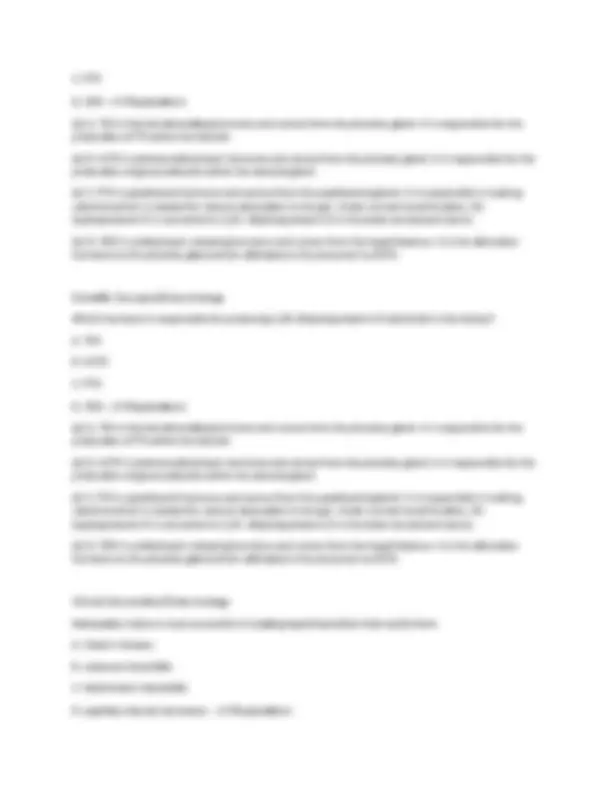
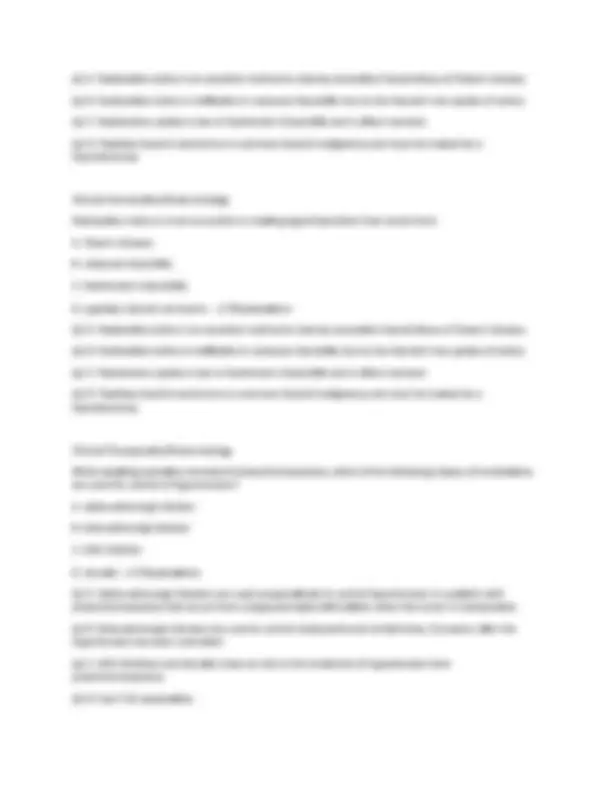
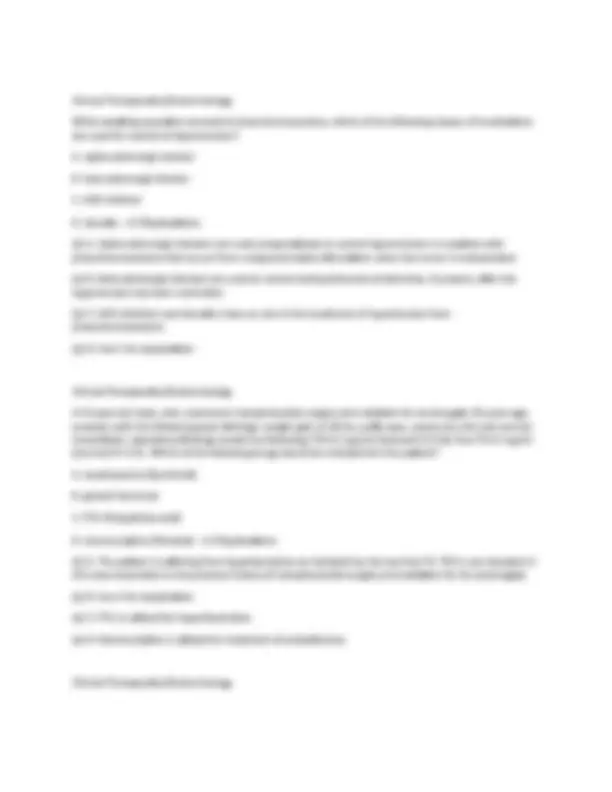
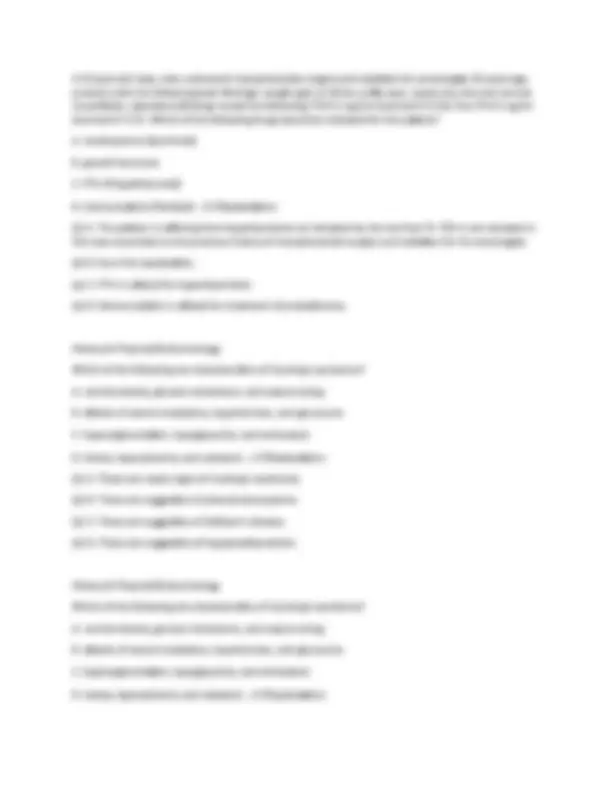
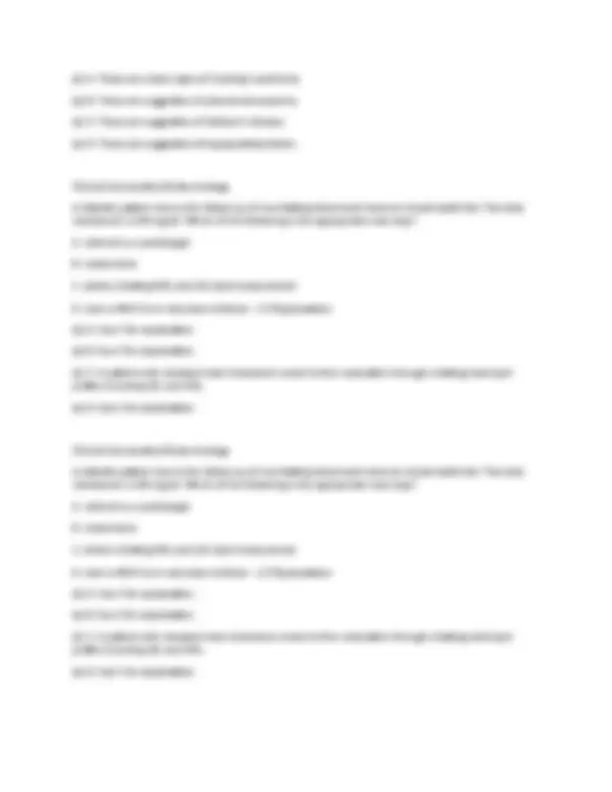
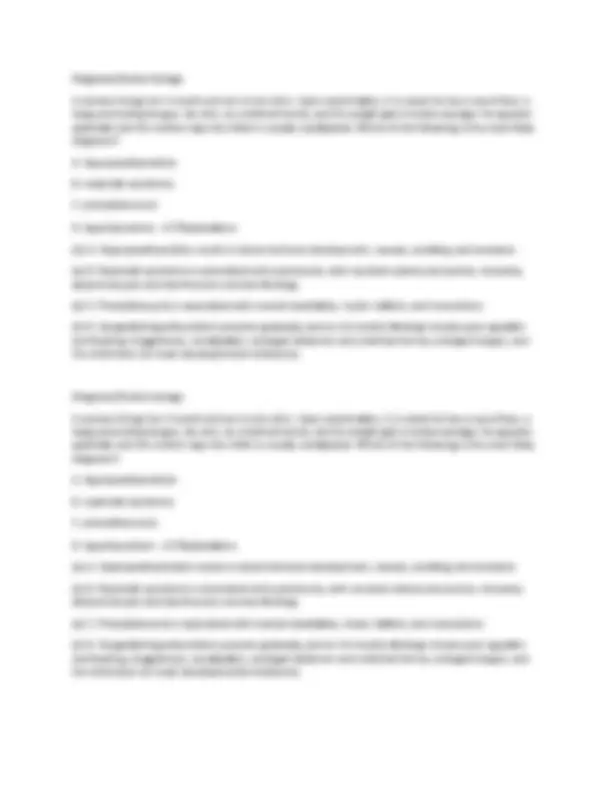
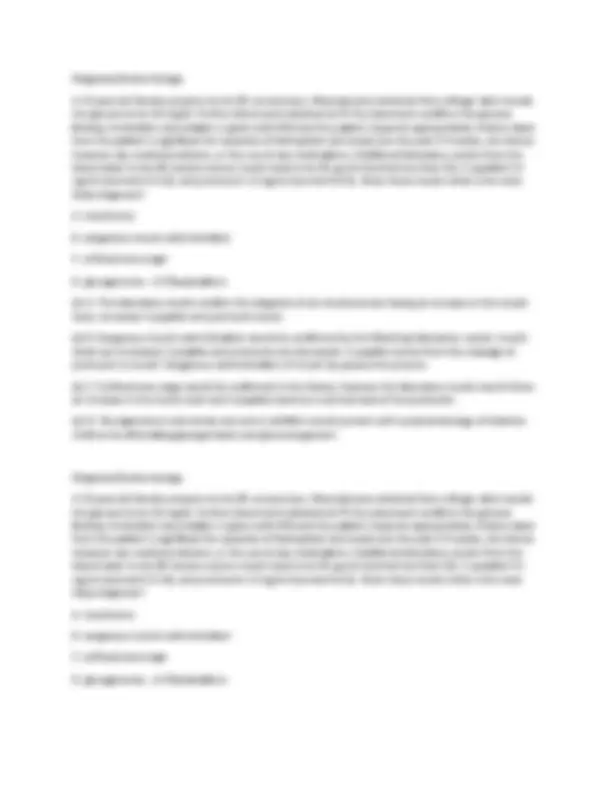
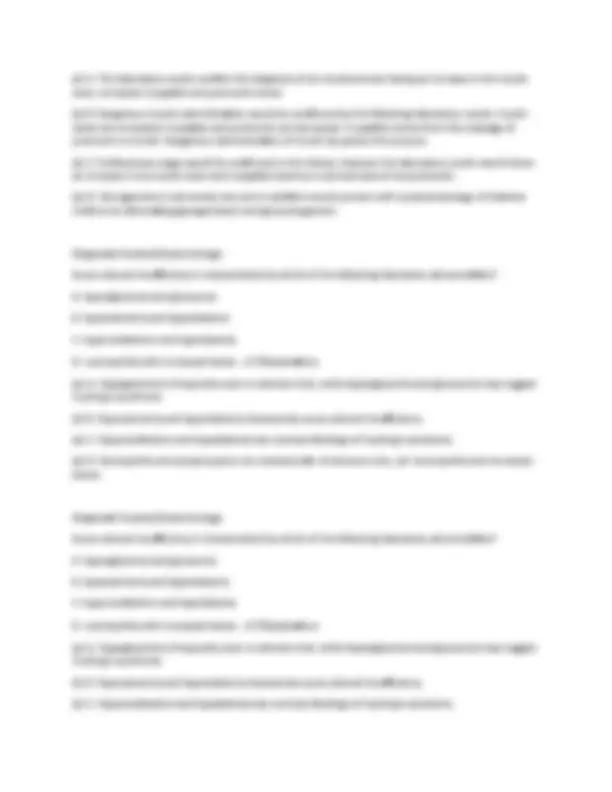
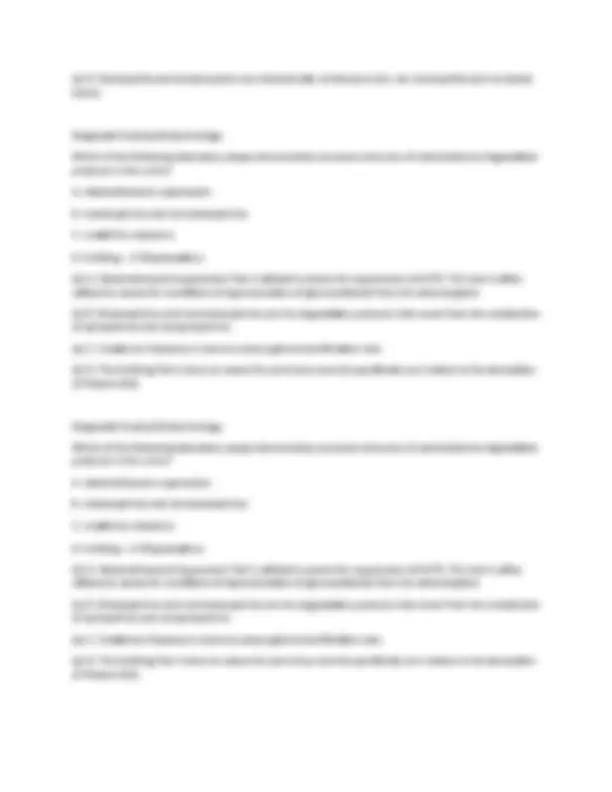
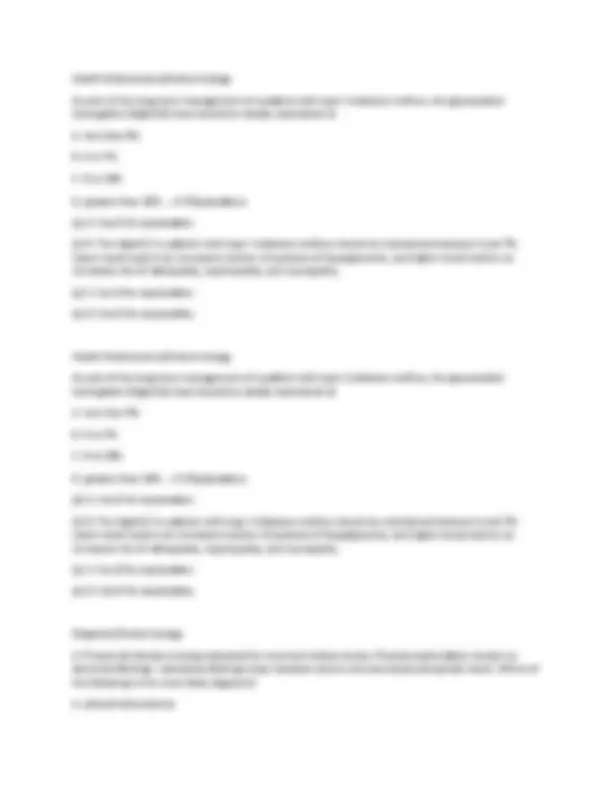
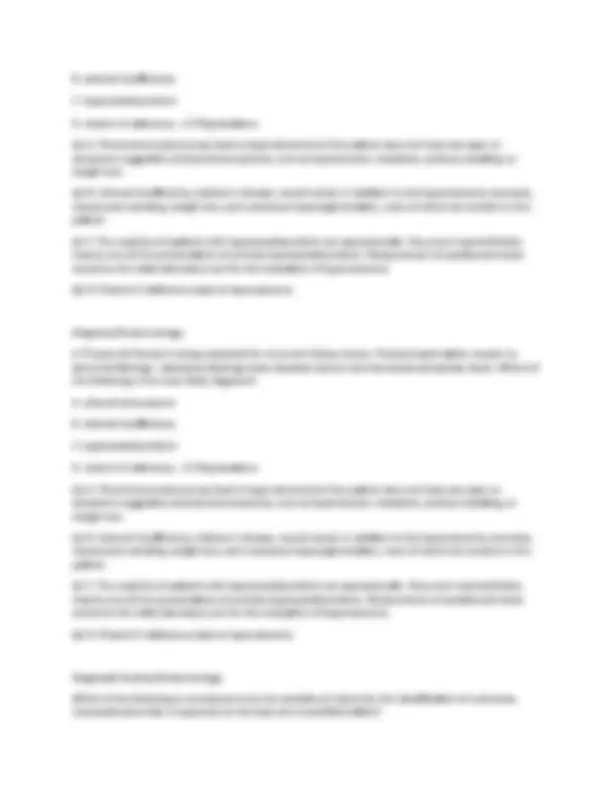
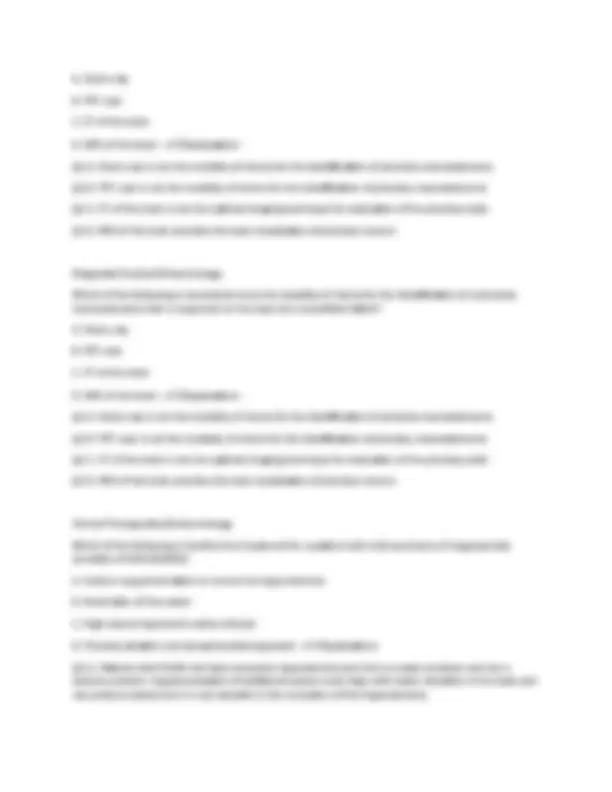
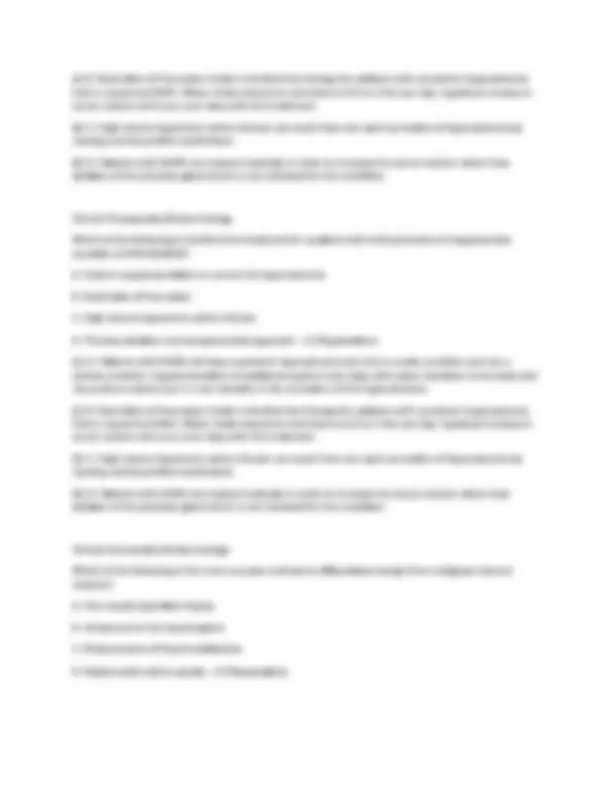


Study with the several resources on Docsity

Earn points by helping other students or get them with a premium plan


Prepare for your exams
Study with the several resources on Docsity

Earn points to download
Earn points by helping other students or get them with a premium plan
Community
Ask the community for help and clear up your study doubts
Discover the best universities in your country according to Docsity users
Free resources
Download our free guides on studying techniques, anxiety management strategies, and thesis advice from Docsity tutors
Explanations and answers to various medical diagnoses, symptoms, and treatments. It covers topics such as skin conditions, infections, neurological disorders, and cardiovascular diseases. Each section includes a question, the answer, and an explanation of the answer.
Typology: Exams
1 / 1235

This page cannot be seen from the preview
Don't miss anything!





























































































History & Physical/Dermatology A patient presents with a rash, characterized by red macules and edematous papules with a clearing center. This best describes which of the following? Answers A. erythema marginatum B. erythema multiforme C. varicella D. impetigo - ✔✔Explanations (u) A. Erythema marginatum is associated with rheumatic fever and is characterized by macular to maculopapular lesions. A clearing center is not found in the rash. (c) B. Target lesions, also termed iris lesions, are characteristic of erythema multiforme. The rash may be recurrent but typically resolves over 3-6 weeks. (u) C. The rash of varicella typically has maculopapules, vesicles, and scabs in various stages of development. A clearing center is not found in the rash. (u) D. The lesions of impetigo are pustules that form a honey-colored crust after rupturing. History & Physical/Dermatology A patient presents with a rash, characterized by red macules and edematous papules with a clearing center. This best describes which of the following? Answers A. erythema marginatum B. erythema multiforme C. varicella D. impetigo - ✔✔Explanations (u) A. Erythema marginatum is associated with rheumatic fever and is characterized by macular to maculopapular lesions. A clearing center is not found in the rash. (c) B. Target lesions, also termed iris lesions, are characteristic of erythema multiforme. The rash may be recurrent but typically resolves over 3-6 weeks.
(u) C. The rash of varicella typically has maculopapules, vesicles, and scabs in various stages of development. A clearing center is not found in the rash. (u) D. The lesions of impetigo are pustules that form a honey-colored crust after rupturing. History & Physical/Dermatology In a patient suspected of having seborrheic dermatitis, the most common site of involvement would be the 10 Answers A. upper extremities. B. thighs. C. scalp. D. feet. - ✔✔Explanations (u) A. See C for explanation. (u) B. See C for explanation. (c) C. The most common site of involvement of seborrheic dermatitis is the scalp. Other common sites include the eyebrows, eyelids, nasolabial fold, and ears. (u) D. See C for explanation. History & Physical/Dermatology In a patient suspected of having seborrheic dermatitis, the most common site of involvement would be the 10 Answers A. upper extremities. B. thighs. C. scalp. D. feet. - ✔✔Explanations (u) A. See C for explanation. (u) B. See C for explanation. (c) C. The most common site of involvement of seborrheic dermatitis is the scalp. Other common sites include the eyebrows, eyelids, nasolabial fold, and ears.
Diagnostic Studies/Dermatology A 35 year-old female who recently returned from a backpacking trip complains of fatigue, malaise, fever, chills, and arthralgias. Physical examination reveals a 6 cm annular lesion with a red border and a clear center on her mid-back. Which of the following laboratory tests would support your diagnosis? Answers A. KOH prep of skin scrapings B. Blood cultures C. RAST testing D. Serologic antibody testing - ✔✔Explanations (u) A. Although the skin lesion may resemble a fungal infection, a fungal dermatophyte would not present with systemic symptoms. (u) B. Culturing of Borrelia burgdorferi from clinical specimens, with the exception of skin biopsies at the site of the lesion, have resulted in low yields. (u) C. RAST testing is utilized in evaluation of allergies and is not indicated in this situation. (c) D. Most people with Lyme Disease will have a positive serologic test after the first few weeks of infection and this would support the diagnosis. Diagnostic Studies/Dermatology A 35 year-old female who recently returned from a backpacking trip complains of fatigue, malaise, fever, chills, and arthralgias. Physical examination reveals a 6 cm annular lesion with a red border and a clear center on her mid-back. Which of the following laboratory tests would support your diagnosis? Answers A. KOH prep of skin scrapings B. Blood cultures C. RAST testing D. Serologic antibody testing - ✔✔Explanations (u) A. Although the skin lesion may resemble a fungal infection, a fungal dermatophyte would not present with systemic symptoms. (u) B. Culturing of Borrelia burgdorferi from clinical specimens, with the exception of skin biopsies at the site of the lesion, have resulted in low yields. (u) C. RAST testing is utilized in evaluation of allergies and is not indicated in this situation. (c) D. Most people with Lyme Disease will have a positive serologic test after the first few weeks of infection and this would support the diagnosis. Diagnosis/Dermatology
A 56 year-old, right hand dominant, carpenter presents to your clinic complaining of a prolonged bruise under his left thumbnail. He states that he first noticed it one year ago. Physical examination reveals a nontender left thumb with a 6 mm macular lesion located under the distal nail bed. It is mixed dark brown and black in color, with irregular borders. The most likely diagnosis is Answers A. lentigo. B. trauma. C. melanoma. D. nevus. - ✔✔Explanations (u) A. Lentigos are typically uniform in color with well-demarcated borders. (u) B. If the lesion was from trauma, it should have resolved well before one year. (c) C. Acral lentiginous melanoma may occur on the palm, sole, nail bed, or mucus membrane. This lesion is suspicious for a melanoma due to its irregular borders, being variegated in color, and its size. A biopsy is required and will insure the diagnosis. (u) D. A nevus usually has regular, well-demarcated borders. Diagnosis/Dermatology A 56 year-old, right hand dominant, carpenter presents to your clinic complaining of a prolonged bruise under his left thumbnail. He states that he first noticed it one year ago. Physical examination reveals a nontender left thumb with a 6 mm macular lesion located under the distal nail bed. It is mixed dark brown and black in color, with irregular borders. The most likely diagnosis is Answers A. lentigo. B. trauma. C. melanoma. D. nevus. - ✔✔Explanations (u) A. Lentigos are typically uniform in color with well-demarcated borders. (u) B. If the lesion was from trauma, it should have resolved well before one year. (c) C. Acral lentiginous melanoma may occur on the palm, sole, nail bed, or mucus membrane. This lesion is suspicious for a melanoma due to its irregular borders, being variegated in color, and its size. A biopsy is required and will insure the diagnosis. (u) D. A nevus usually has regular, well-demarcated borders. Diagnosis/Dermatology
A person with atopic dermatitis should be advised to Answers A. avoid cutaneous irritants. B. take hot water baths or showers. C. use a high potency glucocorticoid on skin after bathing. D. begin a prophylactic antibiotic. - ✔✔Explanations (c) A. Avoidance of cutaneous irritants, such as wool and other rough clothing, is the cornerstone of therapy for atopic dermatitis. (u) B. Patients should bathe in warm, tepid water, not hot water. (u) C. Topical glucocorticoids of low or medium potency in a cream or ointment base should be used on the skin immediately after bathing. (u) D. Prophylactic antibiotics are not indicated in the treatment of atopic dermatitis. Health Maintenance/Dermatology A person with atopic dermatitis should be advised to Answers A. avoid cutaneous irritants. B. take hot water baths or showers. C. use a high potency glucocorticoid on skin after bathing. D. begin a prophylactic antibiotic. - ✔✔Explanations (c) A. Avoidance of cutaneous irritants, such as wool and other rough clothing, is the cornerstone of therapy for atopic dermatitis. (u) B. Patients should bathe in warm, tepid water, not hot water. (u) C. Topical glucocorticoids of low or medium potency in a cream or ointment base should be used on the skin immediately after bathing. (u) D. Prophylactic antibiotics are not indicated in the treatment of atopic dermatitis. Clinical Intervention/Dermatology An elderly woman presents to your clinic complaining of unilateral facial pain and painful lesions. She also complains of blurred vision in the ipsilateral eye. On examination she has several vesicles on an erythematous base, some of the lesions with crusts. They are distributed in a dermatomal pattern and involve the skin overlying the maxillary region and the tip of her nose. Which of the following is the next most appropriate intervention in the care of this patient?
Answers A. KOH prep B. Culture for bacteria C. Referral to an ophthalmologist D. Application of corticosteroids - ✔✔Explanations (u) A. A KOH prep examining for fungal elements is not indicated in this case. (u) B. While bacterial infection may occur along with the viral infection, a bacterial culture is not usually employed. (c) C. Immediate referral to an ophthalmologist is needed when herpes keratitis is suspected, as in this case. A fluorescein stain of the eye might reveal the typical dendritic corneal lesion. (h) D. Application of corticosteroids may cause proliferation of the virus and should only used by an ophthalmologist Clinical Intervention/Dermatology An elderly woman presents to your clinic complaining of unilateral facial pain and painful lesions. She also complains of blurred vision in the ipsilateral eye. On examination she has several vesicles on an erythematous base, some of the lesions with crusts. They are distributed in a dermatomal pattern and involve the skin overlying the maxillary region and the tip of her nose. Which of the following is the next most appropriate intervention in the care of this patient? 64 Answers A. KOH prep B. Culture for bacteria C. Referral to an ophthalmologist D. Application of corticosteroids - ✔✔Explanations (u) A. A KOH prep examining for fungal elements is not indicated in this case. (u) B. While bacterial infection may occur along with the viral infection, a bacterial culture is not usually employed. (c) C. Immediate referral to an ophthalmologist is needed when herpes keratitis is suspected, as in this case. A fluorescein stain of the eye might reveal the typical dendritic corneal lesion. (h) D. Application of corticosteroids may cause proliferation of the virus and should only used by an ophthalmologist
(u) C. If used in the care of a burn patient, the antibiotic selected should have activity against Pseudomonas and S. aureus. Cefazolin does not have any antipseudomonal activity. (c) D. Reasons for transfer to a burn center include a partial thickness burn covering greater than 10% of total body surface area. In addition, burns in patients with pre-existing medical conditions, such as diabetes, that could complicate their management, prolong recovery, or affect their outcome, is also a reason for transfer to a burn center. Clinical Therapeutics/Dermatology Pharmacologic treatment of a cat bite in the person with no allergies consists of which of the following? Answers A. Trimethoprim-sulfamethoxazole (Bactrim) B. Cephalexin (Keflex) C. Ceftriaxone (Rocephin) D. Amoxicillin-clavulanate (Augmentin) - ✔✔Explanations (u) A. See D for explanation. (u) B. See D for explanation. (u) C. See D for explanation. (c) D. Amoxicillin-clavulanate (Augmentin) has activity against Pasteurella multocida which is the causative agent in the majority of cat bite infections. Clinical Therapeutics/Dermatology Pharmacologic treatment of a cat bite in the person with no allergies consists of which of the following? Answers A. Trimethoprim-sulfamethoxazole (Bactrim) B. Cephalexin (Keflex) C. Ceftriaxone (Rocephin) D. Amoxicillin-clavulanate (Augmentin) - ✔✔Explanations (u) A. See D for explanation. (u) B. See D for explanation. (u) C. See D for explanation. (c) D. Amoxicillin-clavulanate (Augmentin) has activity against Pasteurella multocida which is the causative agent in the majority of cat bite infections.
Scientific Concepts/Dermatology Which of the following is characterized by epidermal hyperplasia and an increase in the epidermal turnover? Answers A. Atopic dermatitis B. Tinea corporis C. Ecthyma D. Psoriasis - ✔✔Explanations (u) A. Inflammation in atopic dermatitis results in lichenification of the skin from itching, which leaves the skin dry and scaly when it resolves. The inflammation is the result of elevated T- lymphocyte activation, defective cell-mediated immunity, and IgE overproduction. Epidermal hyperplasia is not involved in atopic dermatitis. (u) B. Tinea corporis is a fungal infection and is does not have epidermal hyperplasia. (u) C. Erythema is the result of an infection from group A beta-hemolytic streptococcus and contaminated with staphylococci. Like atopic dermatitis and tinea corporis, ecthyma has no epidermal hyperplasia. (c) D. Psoriasis is characterized by an increased epidermal cell turnover, increased numbers of epidermal stem cells, and an abnormal differentiation of keratin. This leads to the classic scale associated with psoriasis. Scientific Concepts/Dermatology Which of the following is characterized by epidermal hyperplasia and an increase in the epidermal turnover? Answers A. Atopic dermatitis B. Tinea corporis C. Ecthyma D. Psoriasis - ✔✔Explanations (u) A. Inflammation in atopic dermatitis results in lichenification of the skin from itching, which leaves the skin dry and scaly when it resolves. The inflammation is the result of elevated T- lymphocyte activation, defective cell-mediated immunity, and IgE overproduction. Epidermal hyperplasia is not involved in atopic dermatitis. (u) B. Tinea corporis is a fungal infection and is does not have epidermal hyperplasia.
As a general rule, sutures in the face should be removed in A. 3 days. B. 5 days. C. 7 days. D. 10 days. - ✔✔Explanations (u) A. See B for explanation. (c) B. Sutures of the face should be removed in 5 days in order to allow for adequate healing and to limit the amount of scarring. (u) C. See B for explanation. (u) D. See B for explanation. Clinical Intervention/Dermatology As a general rule, sutures in the face should be removed in A. 3 days. B. 5 days. C. 7 days. D. 10 days. - ✔✔Explanations (u) A. See B for explanation. (c) B. Sutures of the face should be removed in 5 days in order to allow for adequate healing and to limit the amount of scarring. (u) C. See B for explanation. (u) D. See B for explanation. Diagnosis/Dermatology A mother brings a 3 month-old infant to the office because she is concerned about a red, vascular, nodular growth on the child's back. It appears to be enlarging slightly and the vessels are slightly dilated. It seems to cause the child no discomfort. The most likely diagnosis is A. a hemangioma. B. a pigmented nevus. C. a salmon patch (stork bite). D. a malignant melanoma. - ✔✔Explanations (c) A. A hemangioma is a bright red to deep purple vascular nodule or plaque that often develops at birth, may enlarge, and may regress and disappear with aging.
(u) B. A pigmented nevus is not a vascular lesion. (u) C. A salmon patch is a light red macule over the nape of the neck or the glabella. (u) D. A malignant melanoma presents as a hyperpigmented, asymmetric lesion with irregular borders and is typically seen in the adult population. Diagnosis/Dermatology A mother brings a 3 month-old infant to the office because she is concerned about a red, vascular, nodular growth on the child's back. It appears to be enlarging slightly and the vessels are slightly dilated. It seems to cause the child no discomfort. The most likely diagnosis is A. a hemangioma. B. a pigmented nevus. C. a salmon patch (stork bite). D. a malignant melanoma. - ✔✔Explanations (c) A. A hemangioma is a bright red to deep purple vascular nodule or plaque that often develops at birth, may enlarge, and may regress and disappear with aging. (u) B. A pigmented nevus is not a vascular lesion. (u) C. A salmon patch is a light red macule over the nape of the neck or the glabella. (u) D. A malignant melanoma presents as a hyperpigmented, asymmetric lesion with irregular borders and is typically seen in the adult population. History & Physical/Dermatology Erythema nodosum is characterized by A. subcutaneous red tender nodules. B. brown pigmentation on the lower extremities. C. tender lymph nodes in the groin. D. scaling red macules. - ✔✔Explanations (c) A. Erythema nodosum produces erythematous red tender nodules, especially on the shins. (u) B. Brown pigmentation on the lower extremities is a feature of chronic venous insufficiency. (u) C. Lymphovenereum granuloma is likely to produce tender lymph nodes in the groin as can acute infection in the lower extremities. (u) D. Scaling red macules are a feature of tinea corporis.
(u) C. Prednisone is used to treat urticaria. (c) D. IgE triggers the release of histamine from mast cells that leads to urticaria. Clinical Therapeutics/Dermatology A 45 year-old female presents to the emergency department with generalized, hot, erythema of the skin. Physical exam reveals an oral temperature of 102 degrees Fahrenheit, purulent conjunctivitis, and mucosal erosions. Her skin is painful and separates from the dermis with touch. Which of the following is the most likely cause for this condition? A. Ampicillin B. Prednisolone C. Aspirin D. Hydrochlorothiazide (HCTZ) - ✔✔Explanations (c) A. Medications are most frequently implicated in toxic epidermal necrolysis. These usually include, analgesics (NSAIDs), antibiotics (Ampicillin) and anticonvulsants (Carbamazepine). (u) B. Systemic glucocorticoids may be used early in the treatment of this condition and are not a cause. (u) C. Aspirin is not linked to toxic epidermal necrolysis. (u) D. Hydrochlorothiazide diuretics are not associated with the production of toxic epidermal necrolysis. Clinical Therapeutics/Dermatology A 45 year-old female presents to the emergency department with generalized, hot, erythema of the skin. Physical exam reveals an oral temperature of 102 degrees Fahrenheit, purulent conjunctivitis, and mucosal erosions. Her skin is painful and separates from the dermis with touch. Which of the following is the most likely cause for this condition? A. Ampicillin B. Prednisolone C. Aspirin D. Hydrochlorothiazide (HCTZ) - ✔✔Explanations (c) A. Medications are most frequently implicated in toxic epidermal necrolysis. These usually include, analgesics (NSAIDs), antibiotics (Ampicillin) and anticonvulsants (Carbamazepine). (u) B. Systemic glucocorticoids may be used early in the treatment of this condition and are not a cause. (u) C. Aspirin is not linked to toxic epidermal necrolysis. (u) D. Hydrochlorothiazide diuretics are not associated with the production of toxic epidermal necrolysis. Diagnosis/Dermatology
A patient presents with loss of pigmentation on the back of hands, face, and body folds due to the absence of epidermal melanocytes. There has been improvement with PUVA treatment. Which of the following is the most likely diagnosis? A. Pityriasis alba B. Tinea versicolor C. Vitiligo D. Melasma - ✔✔Explanations (u) A. Pityriasis alba is caused by dermal inflammation that becomes scaly and hypopigmented. (u) B. Tinea versicolor is a fungal infection of the skin presenting as oval or circular lesions (c) C. Vitiligo is the acquired loss of pigmentation due to the absence of epidermal melanocytes presenting on the back of hands, face, or body folds. (u) D. Melasma is an acquired brown hyperpigmentation involving the face and neck in women during their second or third trimester of pregnancy. Diagnosis/Dermatology A patient presents with loss of pigmentation on the back of hands, face, and body folds due to the absence of epidermal melanocytes. There has been improvement with PUVA treatment. Which of the following is the most likely diagnosis? A. Pityriasis alba B. Tinea versicolor C. Vitiligo D. Melasma - ✔✔Explanations (u) A. Pityriasis alba is caused by dermal inflammation that becomes scaly and hypopigmented. (u) B. Tinea versicolor is a fungal infection of the skin presenting as oval or circular lesions (c) C. Vitiligo is the acquired loss of pigmentation due to the absence of epidermal melanocytes presenting on the back of hands, face, or body folds. (u) D. Melasma is an acquired brown hyperpigmentation involving the face and neck in women during their second or third trimester of pregnancy. Diagnostic Studies/Dermatology A 26 year-old female presents with several pruritic lesions on her dorsal forearms. The lesions are erythematous with vesicles, with a few beginning to weep. She works in a photography laboratory, but denies any other possible exposures. Which of the following is the most useful diagnostic test? A. VDRL serology
Diagnostic Studies/Dermatology A positive Wood's light examination (fluorescence) demonstrates A. viral infection with herpes zoster. B. bacterial infection with Treponema pallidum. C. parasitic infestation with Pediculus humanus. D. mycotic infection with Microsporum canis. - ✔✔Explanations (u) A. Lesions of herpes, Treponema, and Pediculus infections do not fluoresce. (u) B. See A for explanation. (u) C. See A for explanation. (c) D. Microsporum causes tinea capitis and fluoresces blue-green under Wood's light. History & Physical/Dermatology In which of the following patients would one most likely find acanthosis nigricans? A. A 55 year-old obese female with hyperinsulinemia B. A 55 year-old male with an enlarged spleen and pancytopenia C. A 24 year-old female with increased Lyme titers D. A 60 year-old male with increased triglycerides - ✔✔Explanations (c) A. Acanthosis nigricans is associated with patients who have hyperinsulinemia. (u) B. Hairy cell leukemia is associated with an enlarged spleen and pancytopenia. Acanthosis nigricans is not a cutaneous manifestation. (u) C. Erythema chronicum migrans is the characteristic lesion associated with Lyme disease. (u) D. Eruptive xanthelasma is associated with increased triglycerides. History & Physical/Dermatology In which of the following patients would one most likely find acanthosis nigricans? A. A 55 year-old obese female with hyperinsulinemia B. A 55 year-old male with an enlarged spleen and pancytopenia C. A 24 year-old female with increased Lyme titers
D. A 60 year-old male with increased triglycerides - ✔✔Explanations (c) A. Acanthosis nigricans is associated with patients who have hyperinsulinemia. (u) B. Hairy cell leukemia is associated with an enlarged spleen and pancytopenia. Acanthosis nigricans is not a cutaneous manifestation. (u) C. Erythema chronicum migrans is the characteristic lesion associated with Lyme disease. (u) D. Eruptive xanthelasma is associated with increased triglycerides. Clinical Intervention/Dermatology Which of the following interventions is the treatment of choice for actinic keratosis? A. Mohs surgery B. Cryotherapy C. Acid peels D. Radiation therapy - ✔✔Explanations (u) A. Mohs surgery and radiation therapy are not indicated in the treatment for actinic keratosis. (c) B. Cryotherapy is the treatment of choice for isolated superficial actinic keratosis. (u) C. Acid peels can be used to treat actinic keratosis but are not the treatment of choice. (u) D. See A for explanation. Clinical Intervention/Dermatology Which of the following interventions is the treatment of choice for actinic keratosis? A. Mohs surgery B. Cryotherapy C. Acid peels D. Radiation therapy - ✔✔Explanations (u) A. Mohs surgery and radiation therapy are not indicated in the treatment for actinic keratosis. (c) B. Cryotherapy is the treatment of choice for isolated superficial actinic keratosis. (u) C. Acid peels can be used to treat actinic keratosis but are not the treatment of choice. (u) D. See A for explanation.